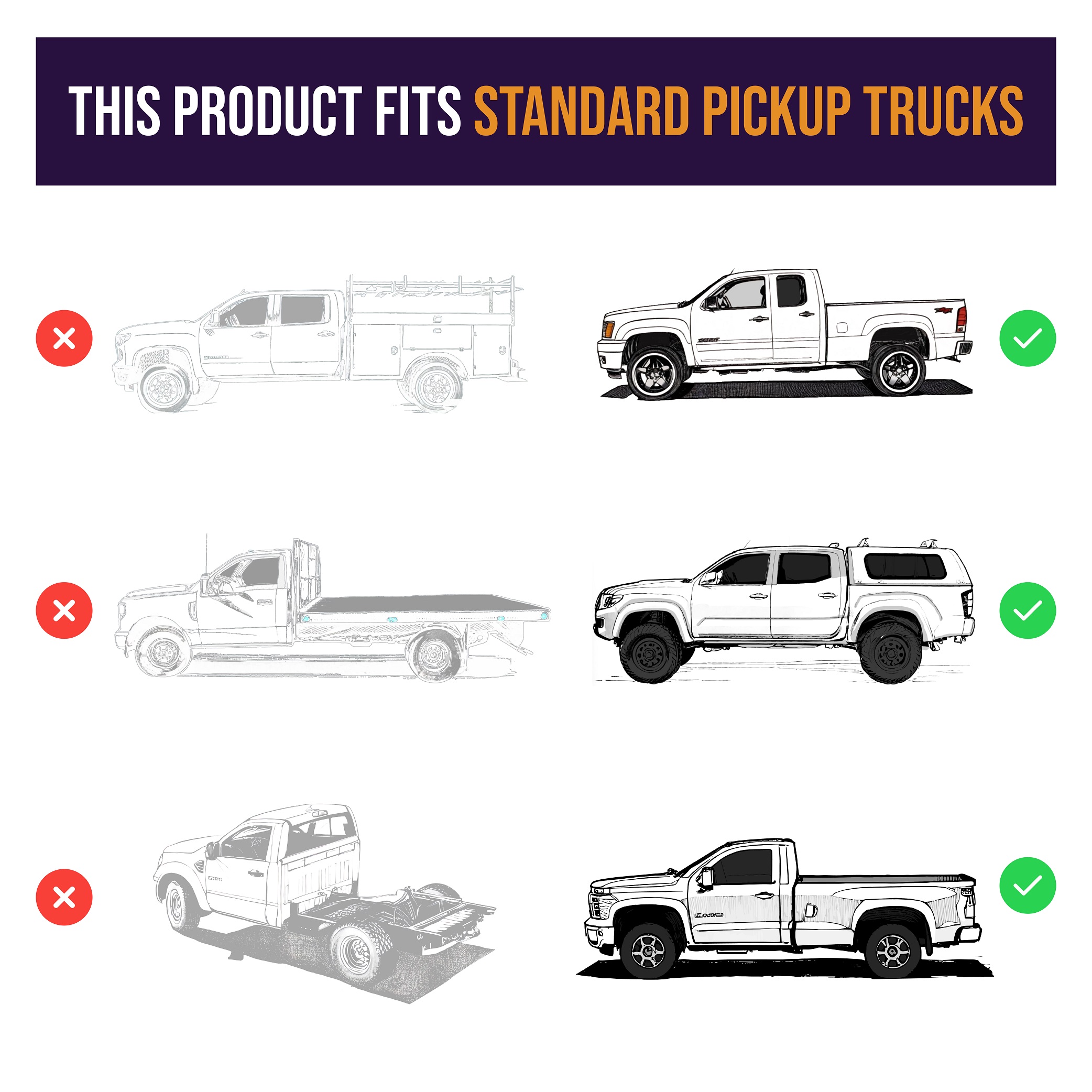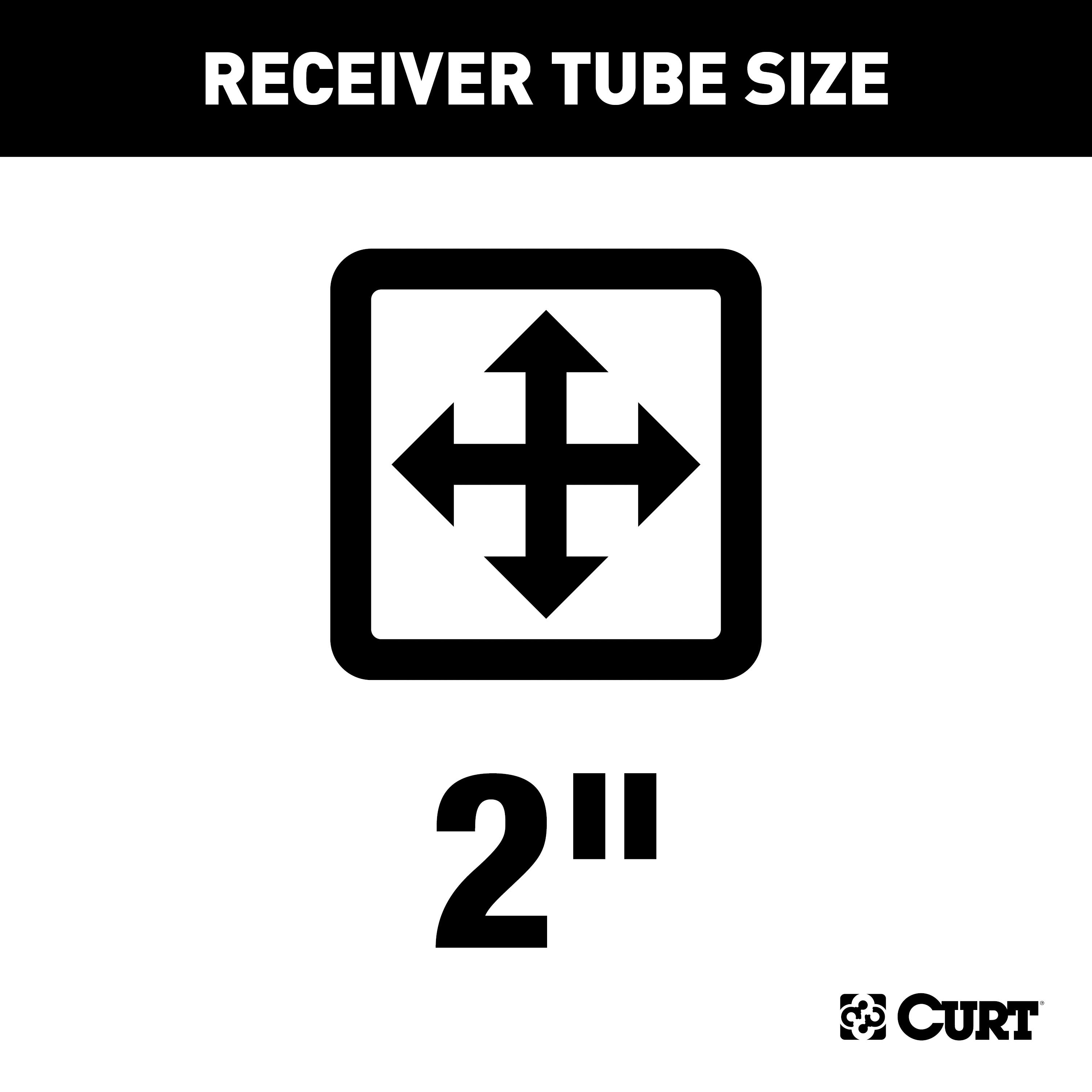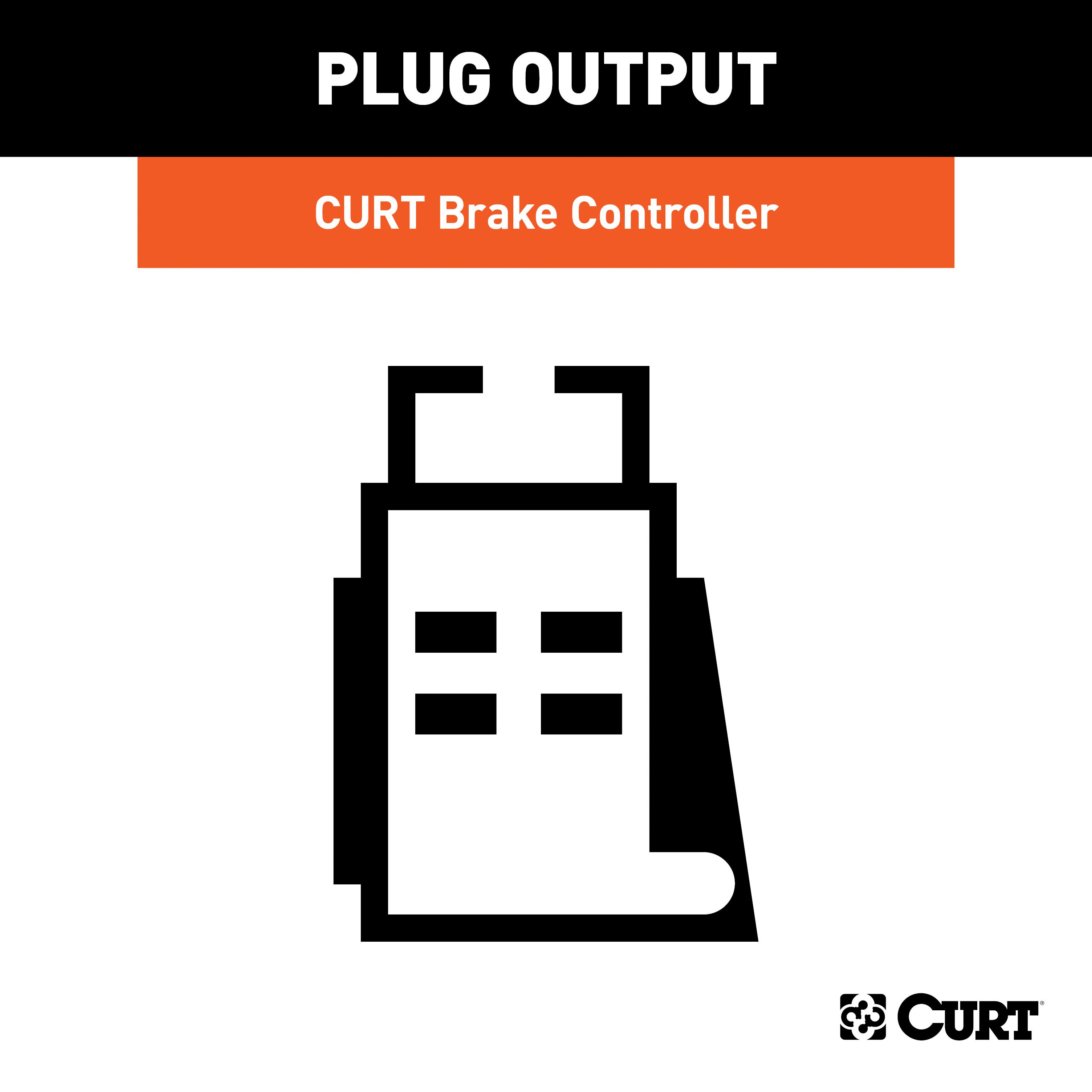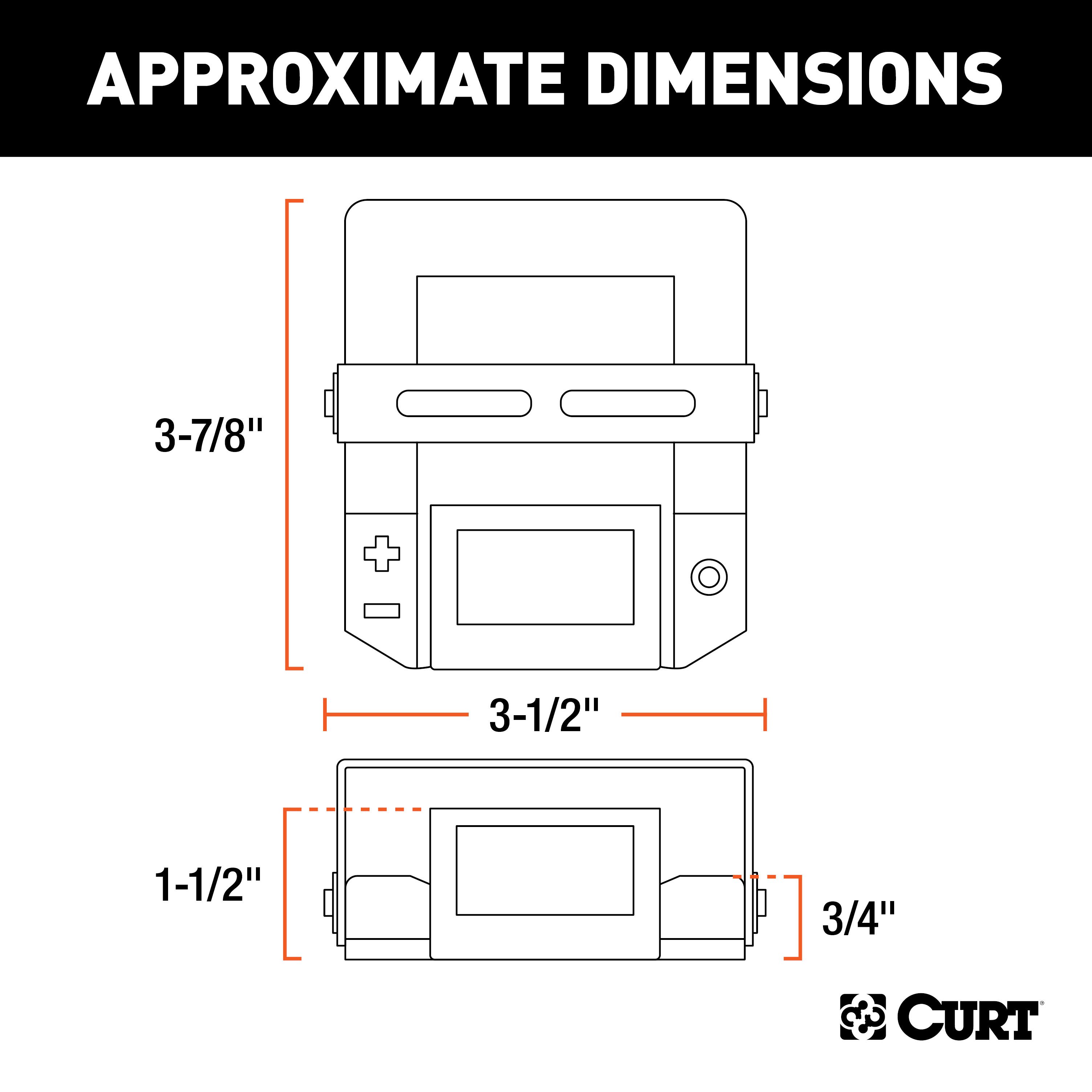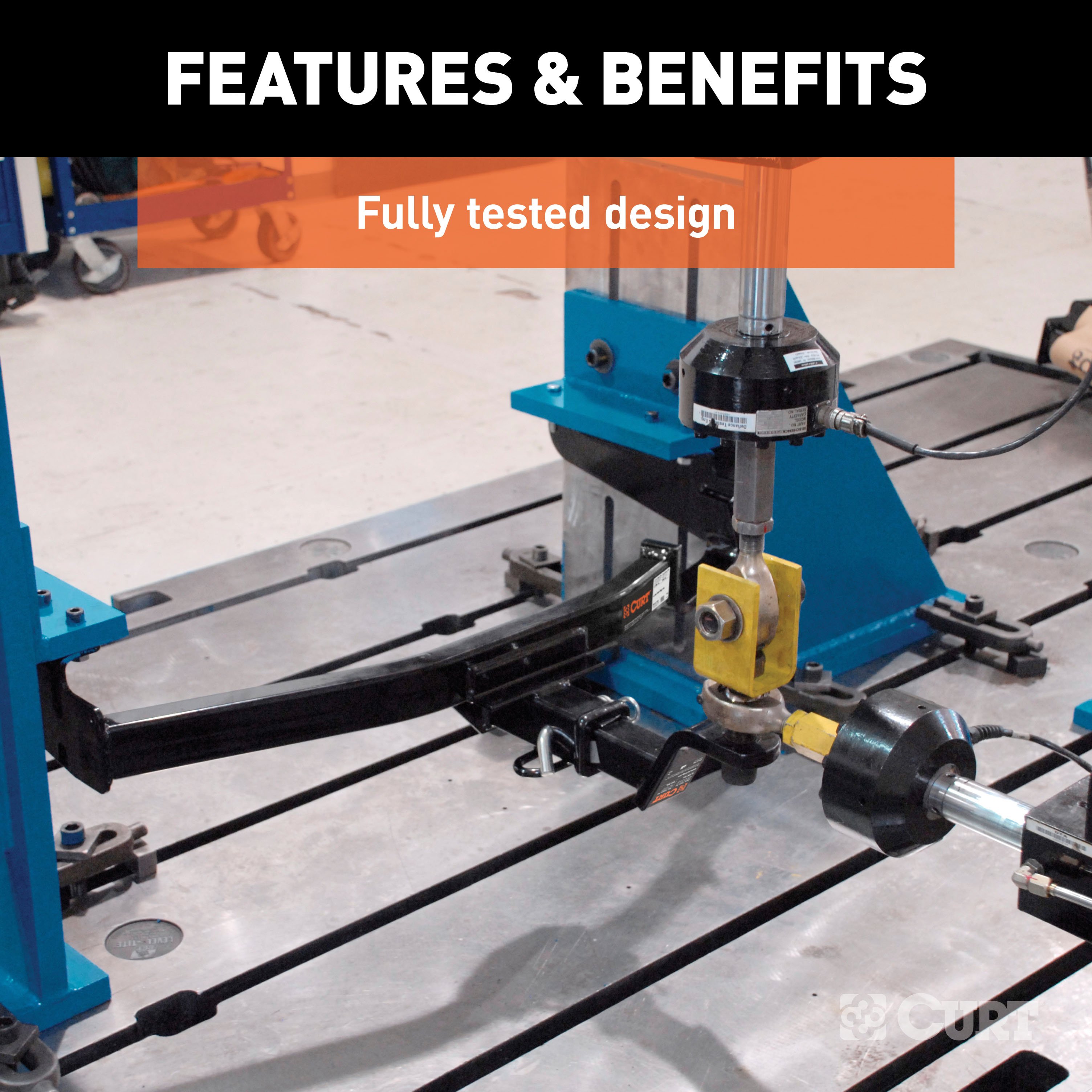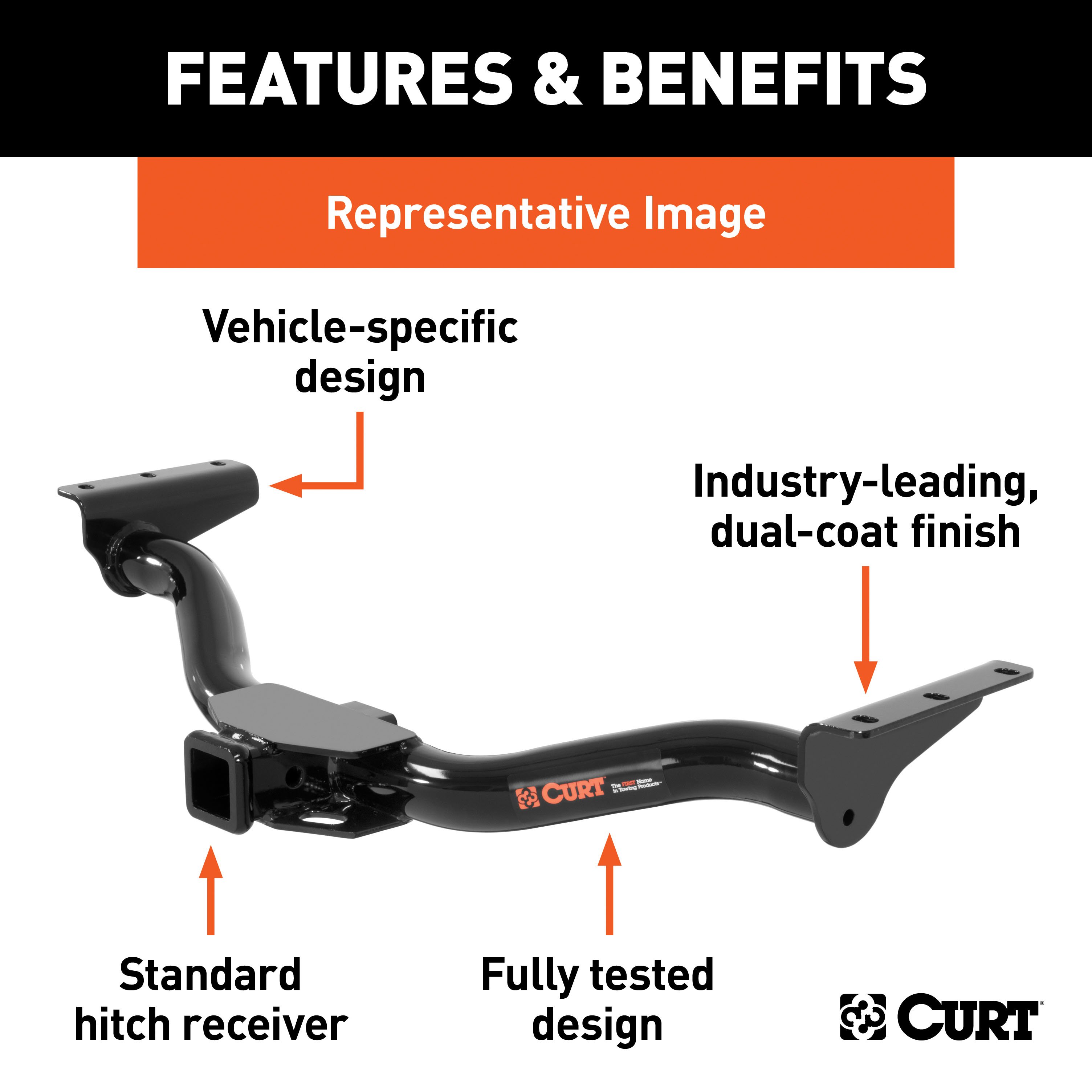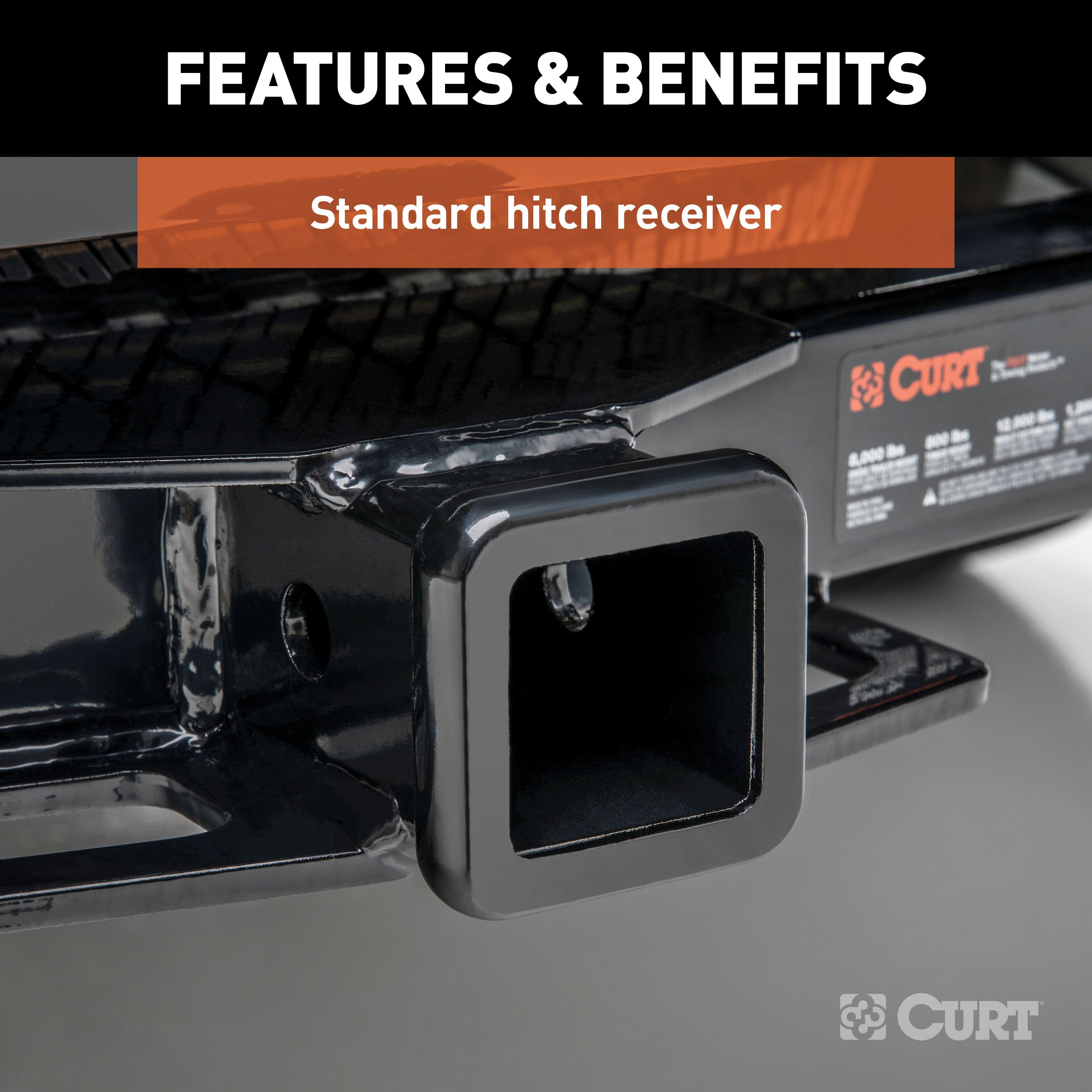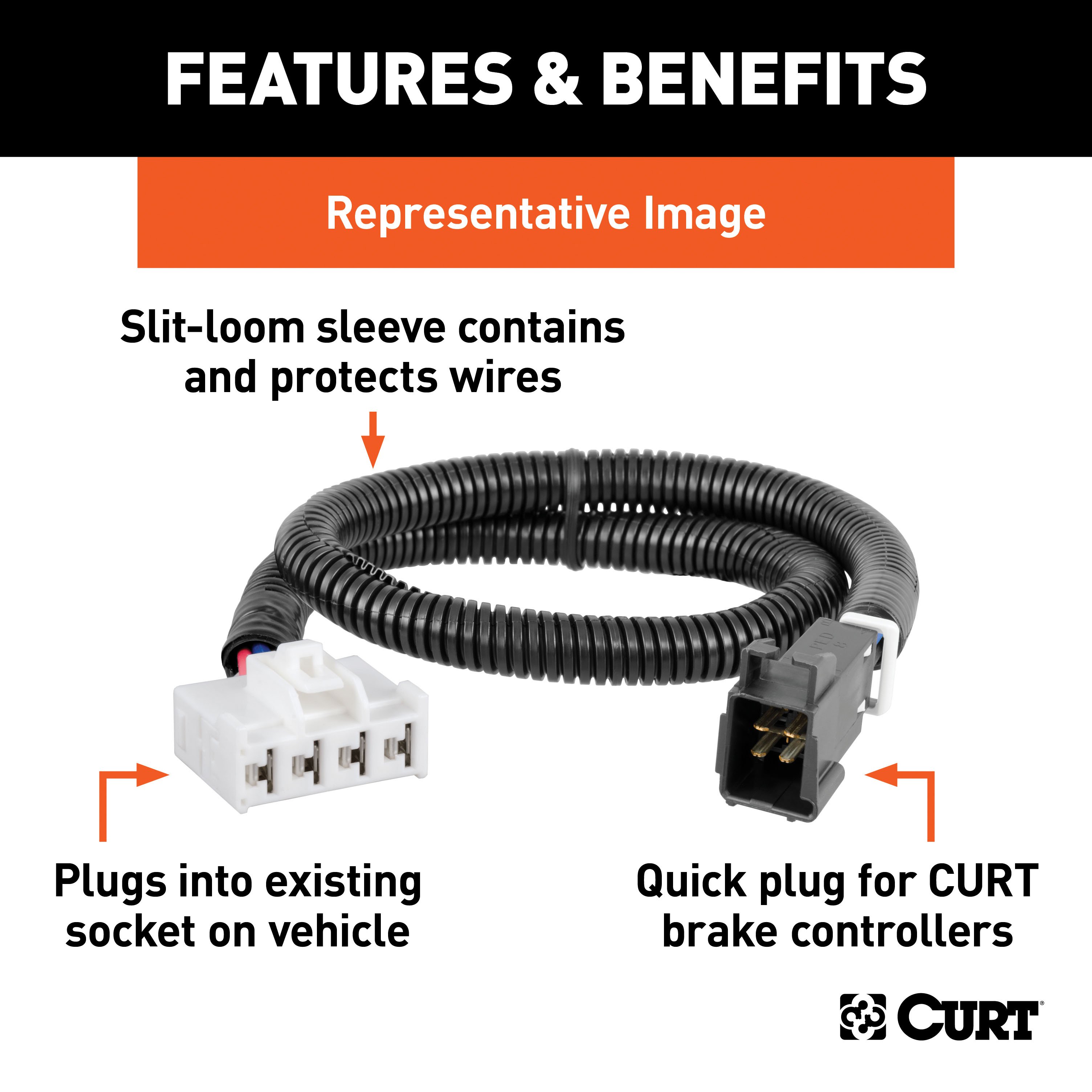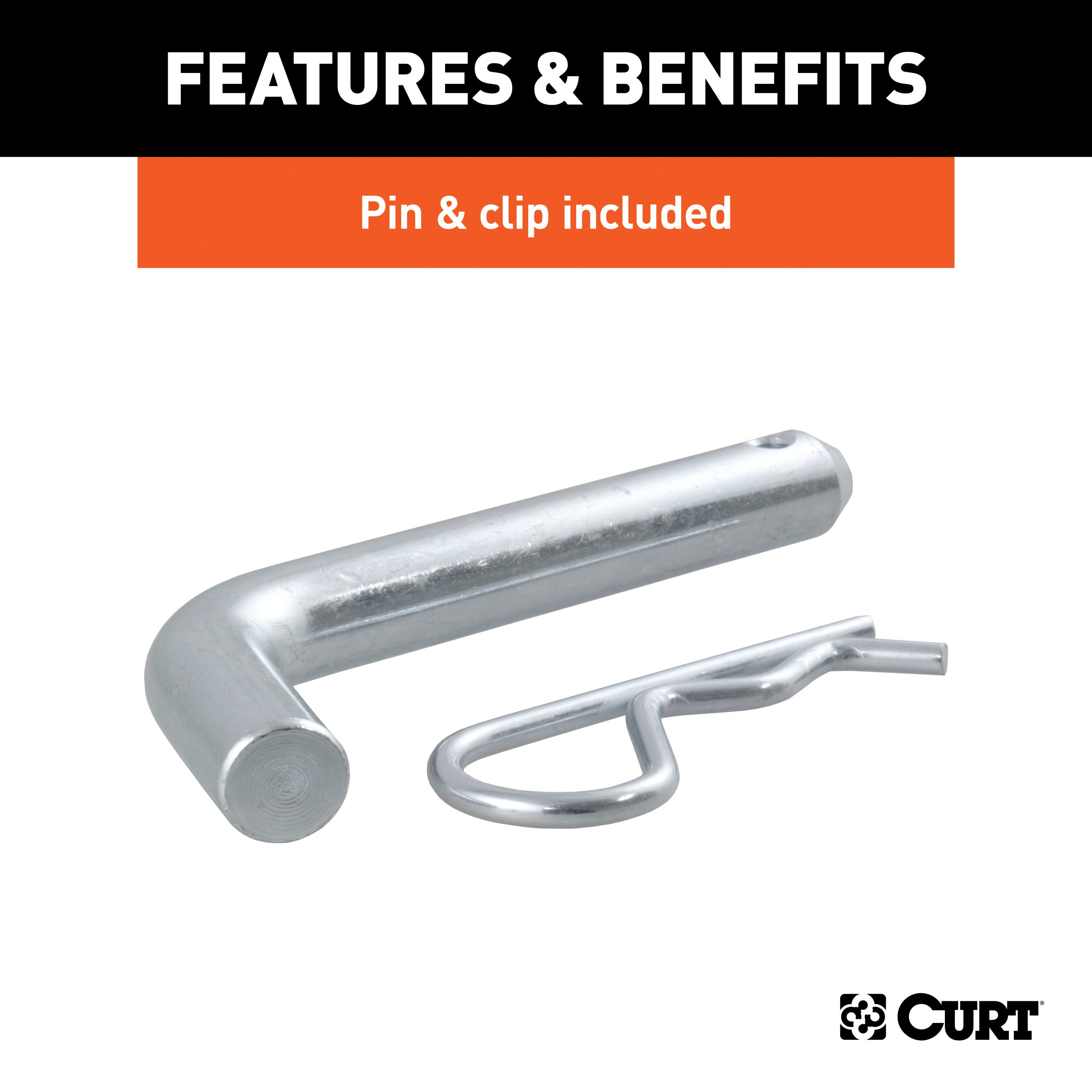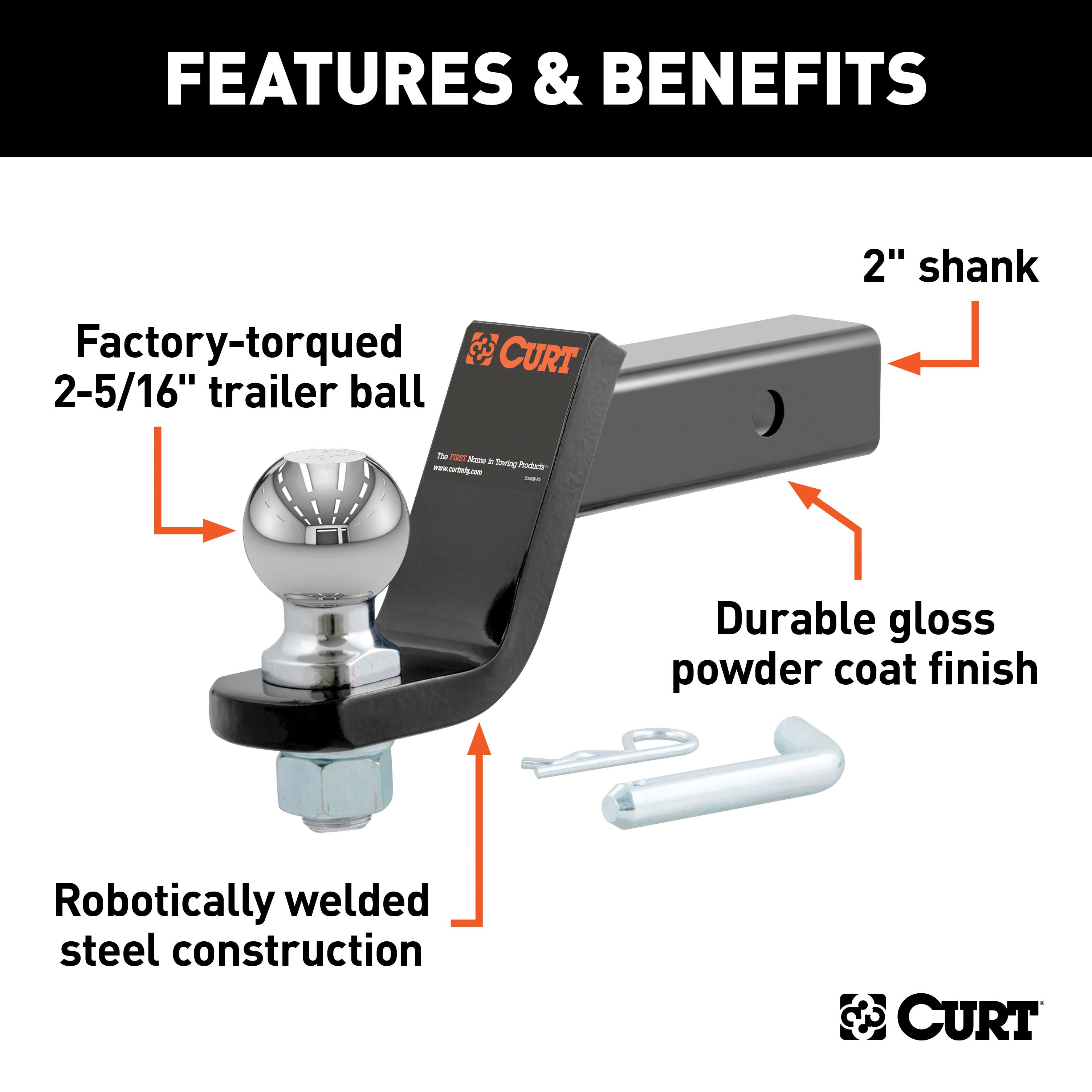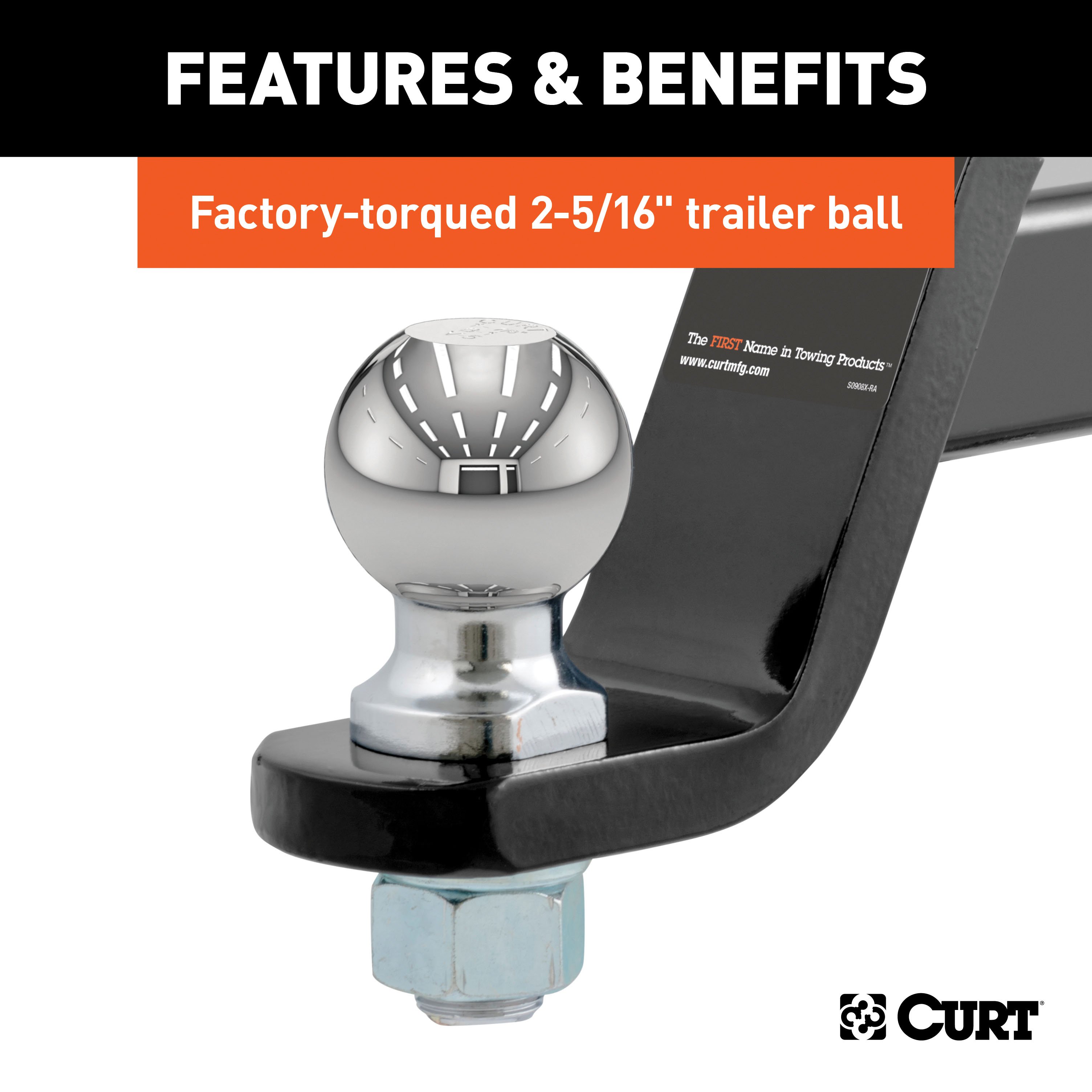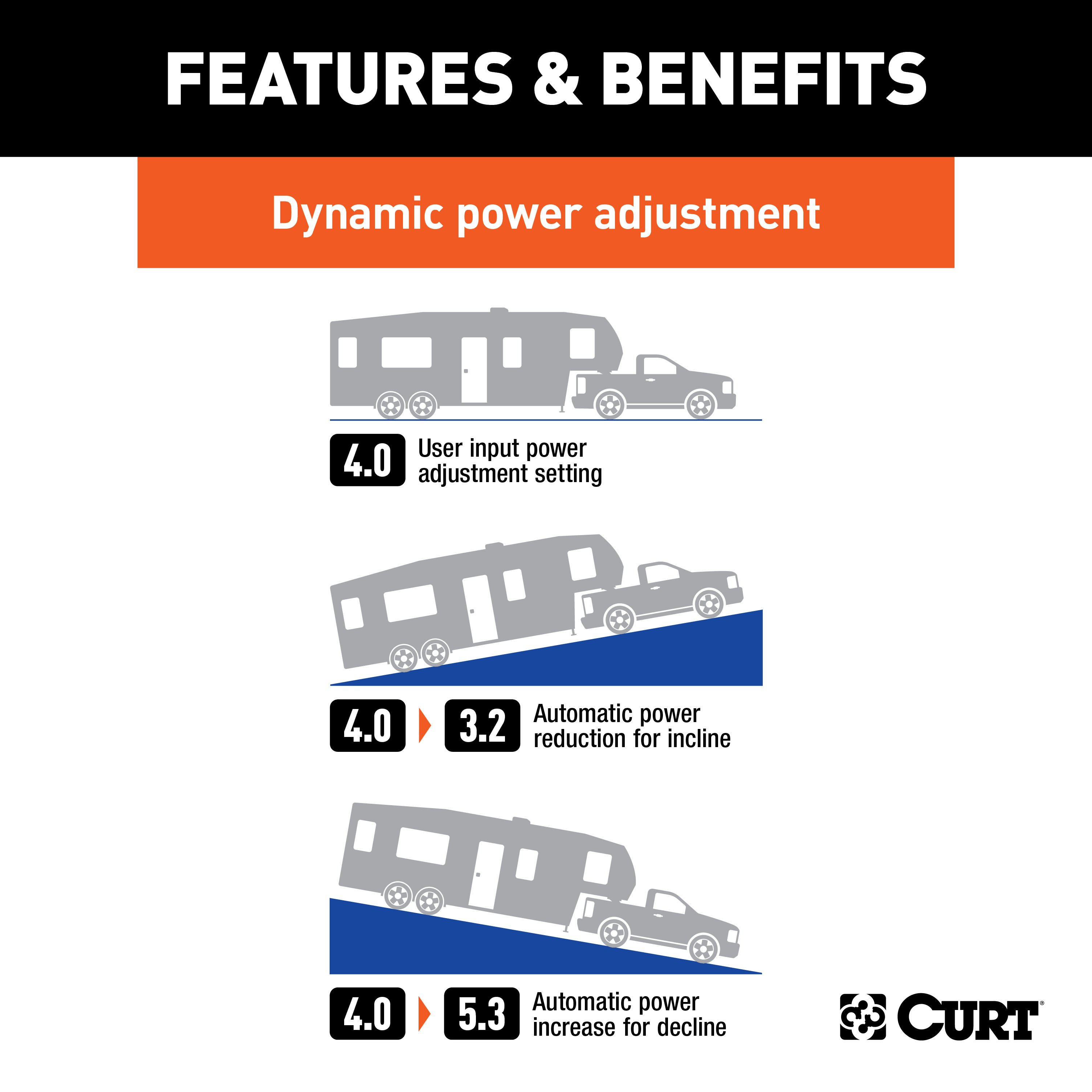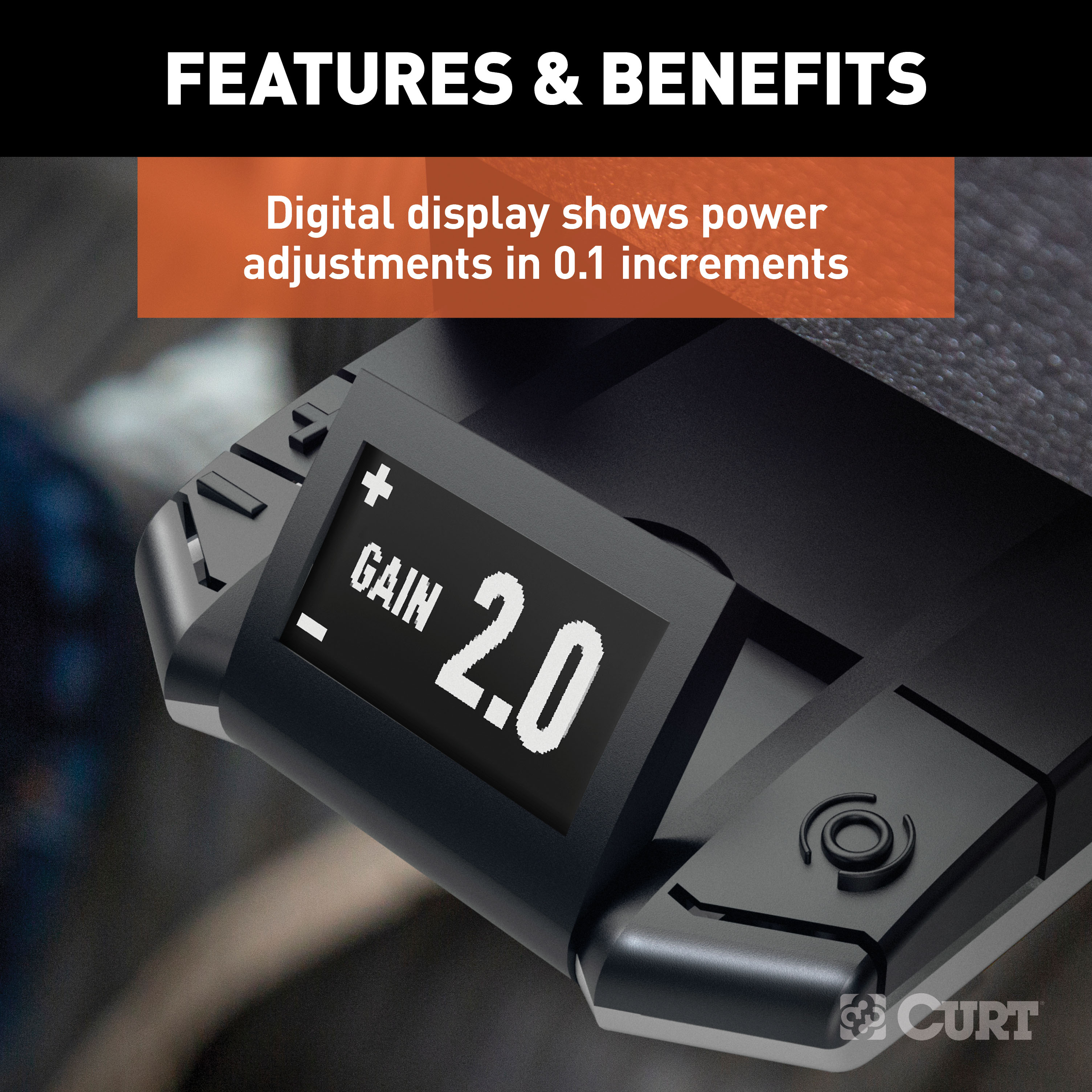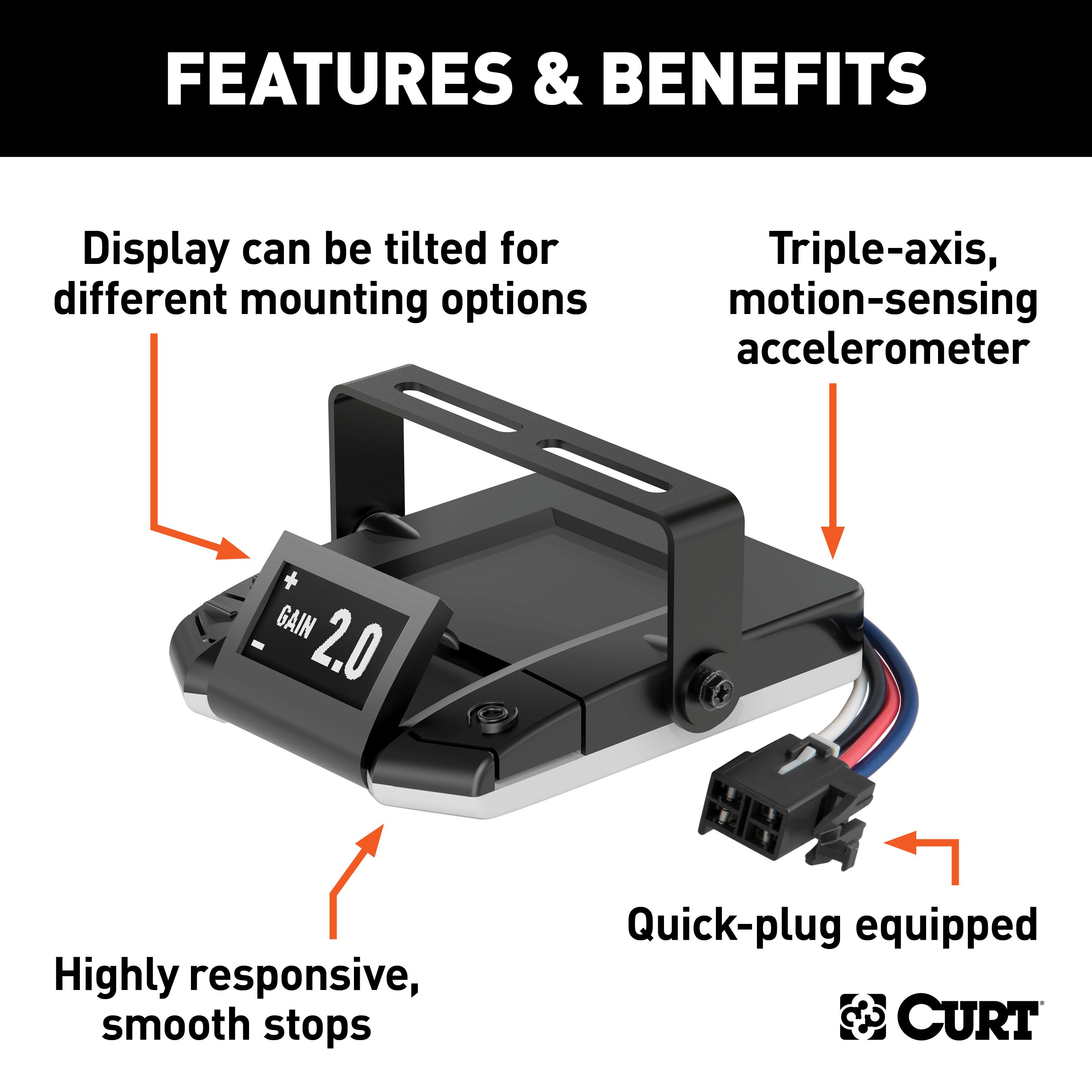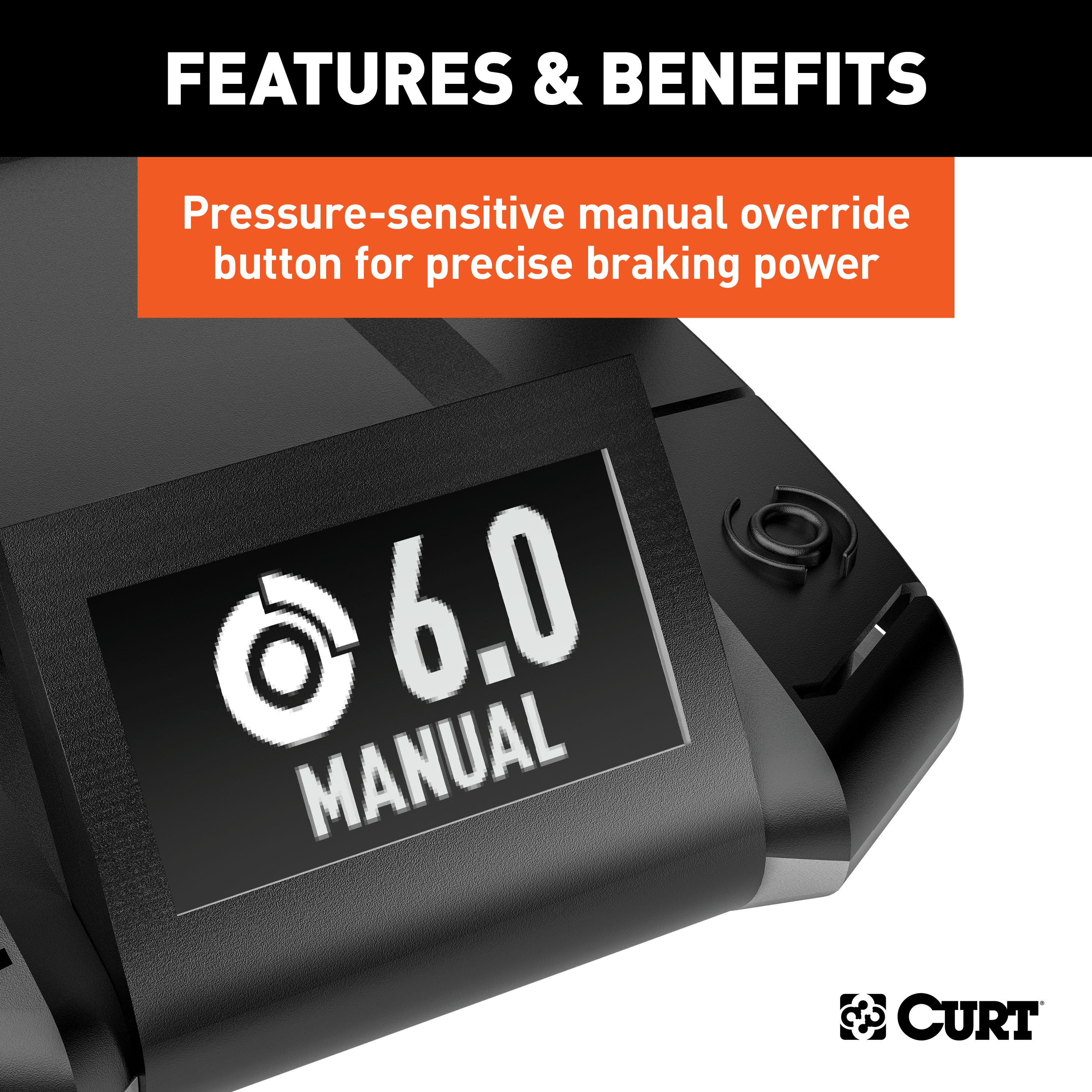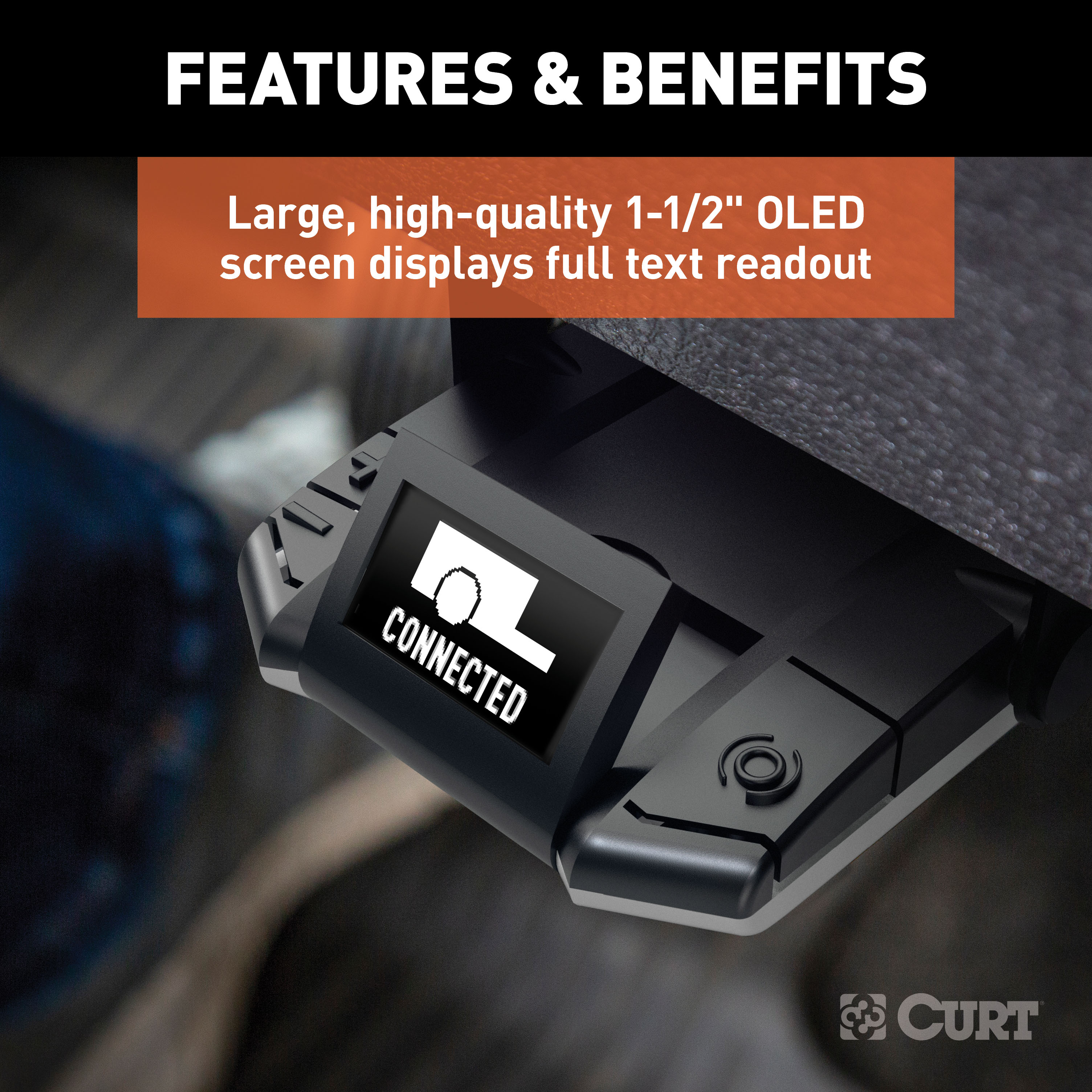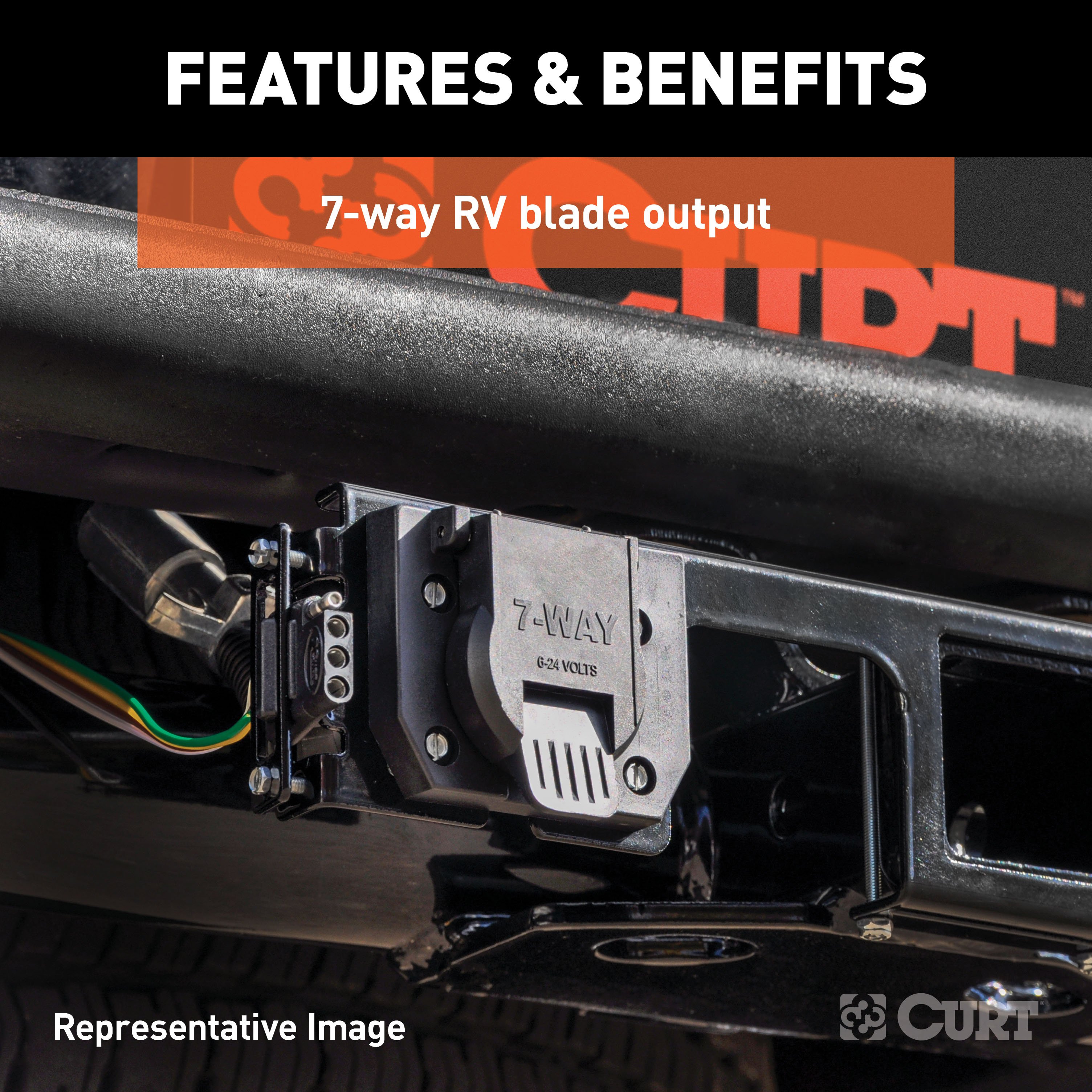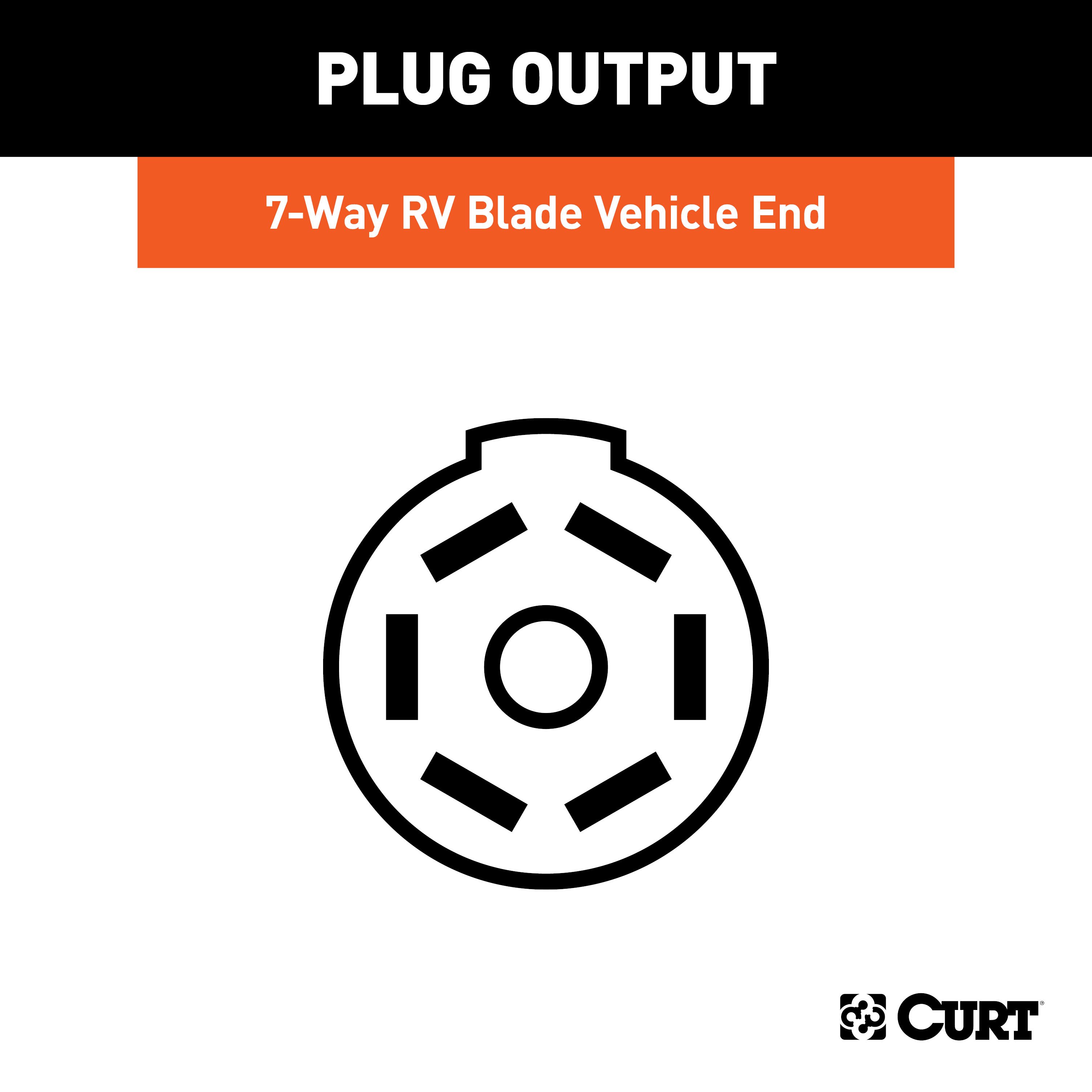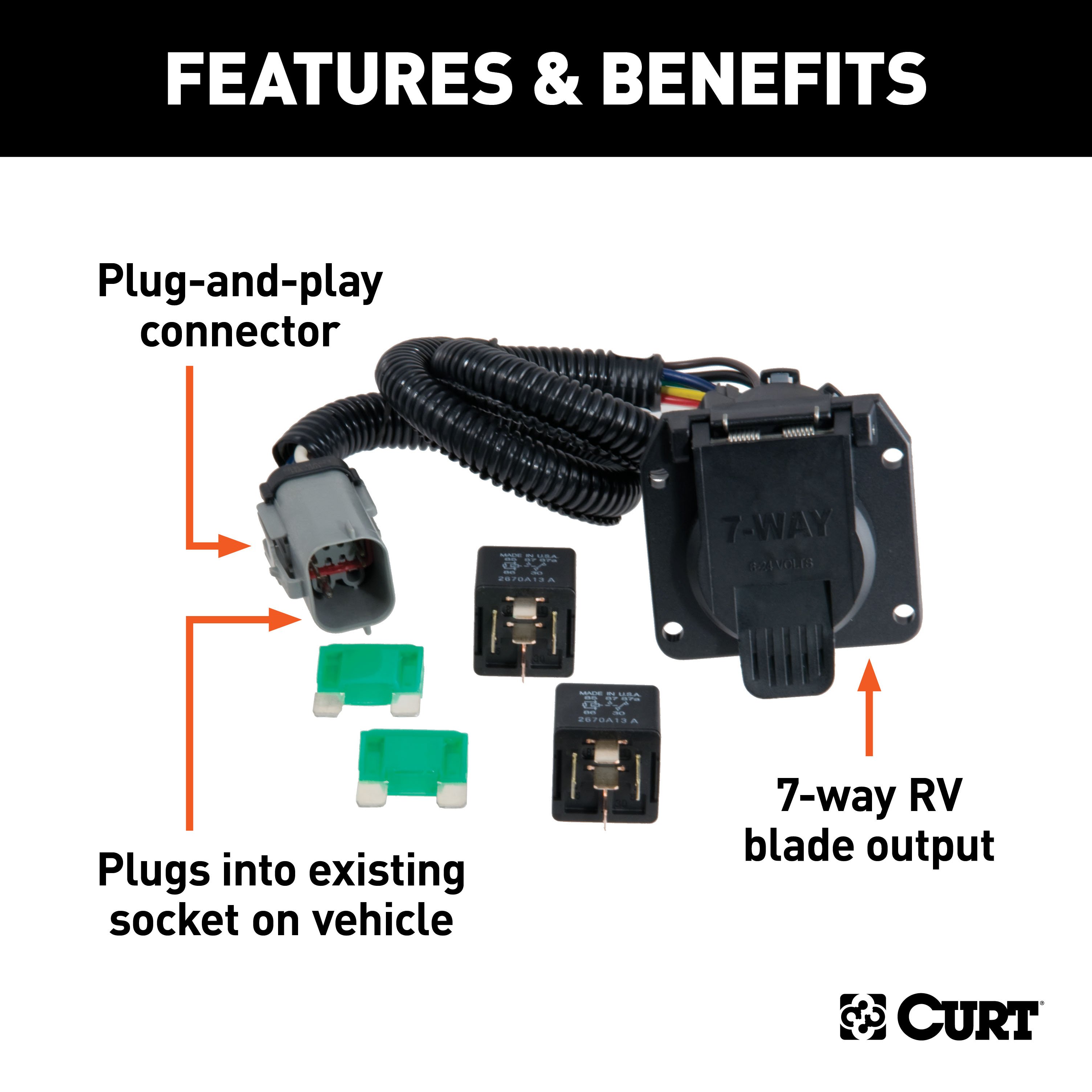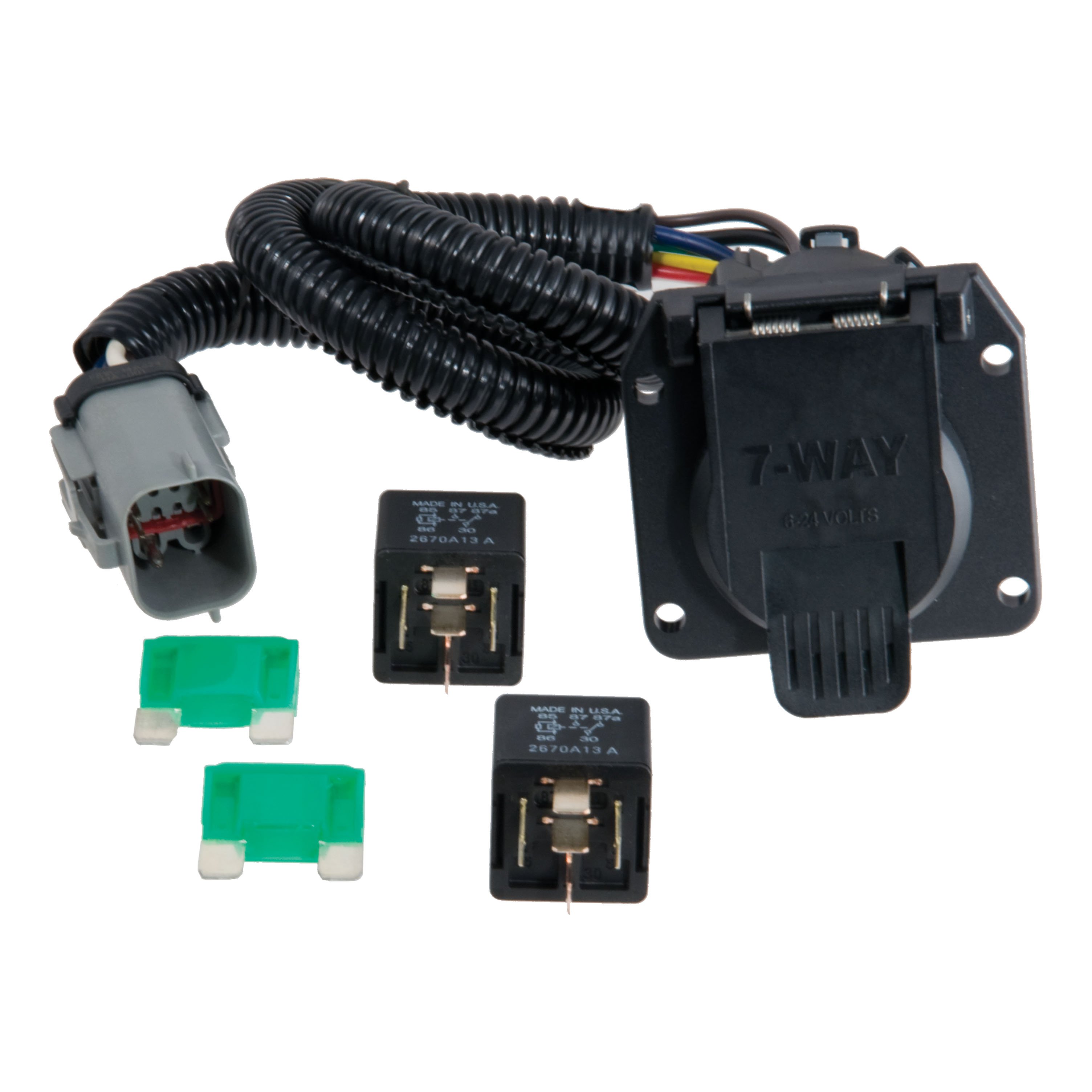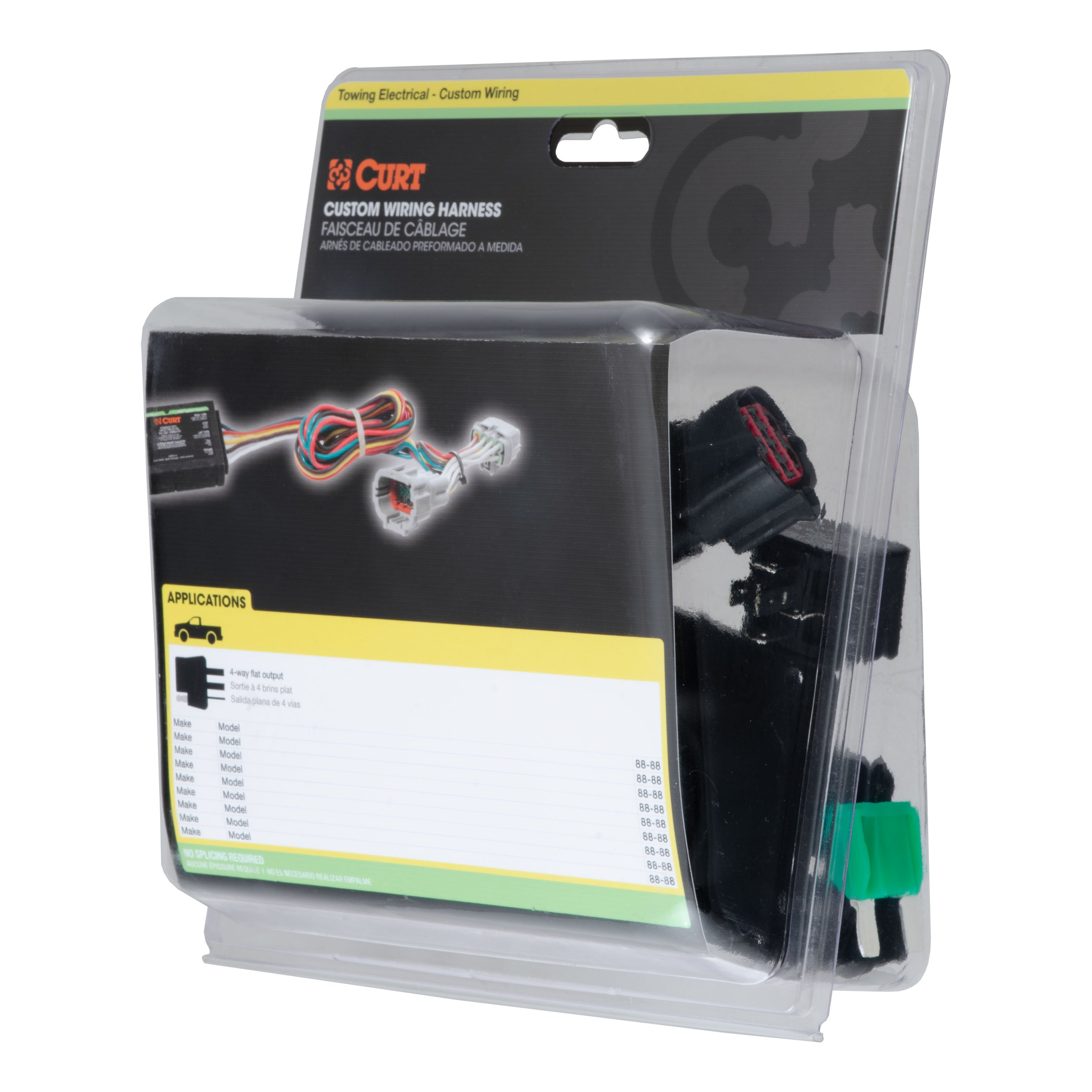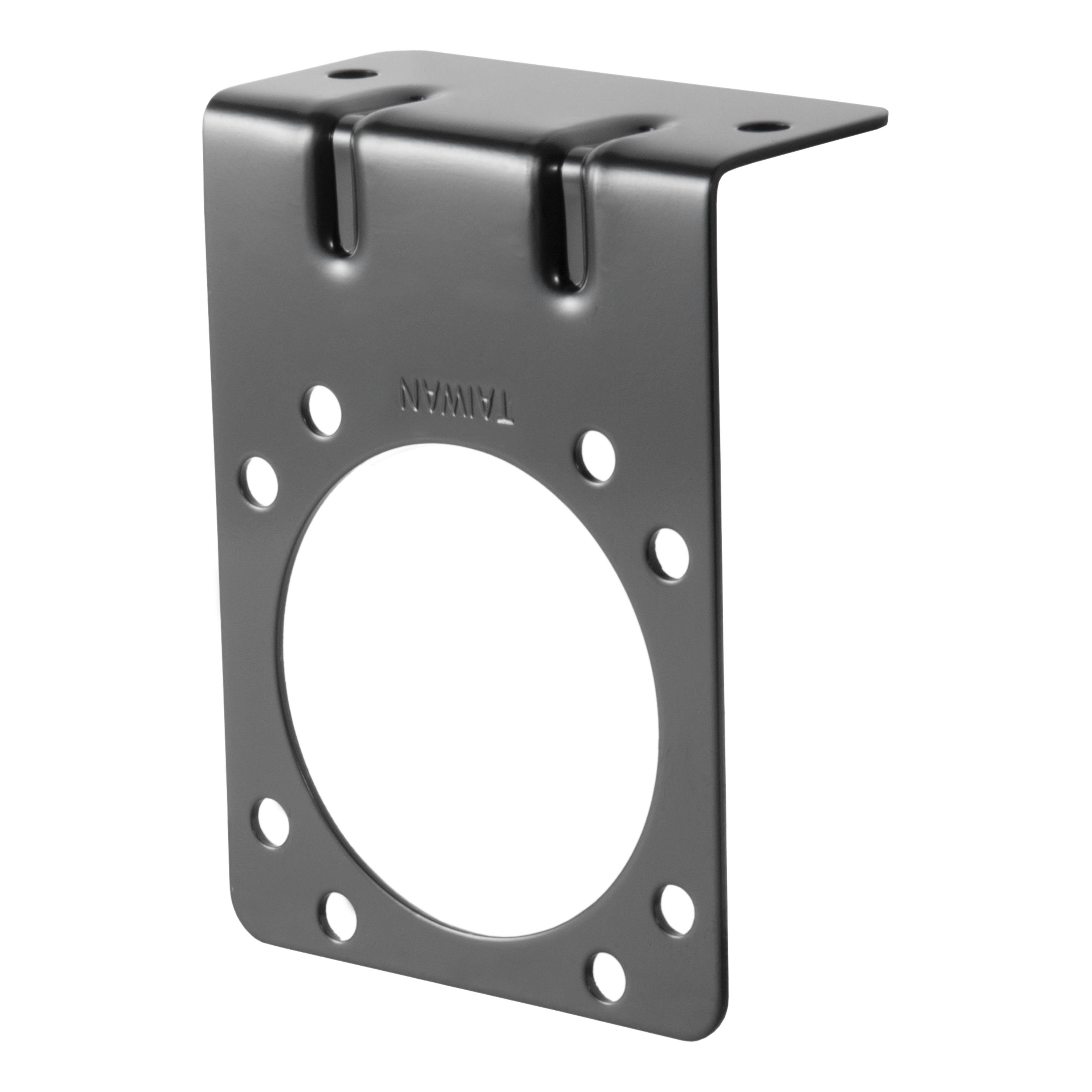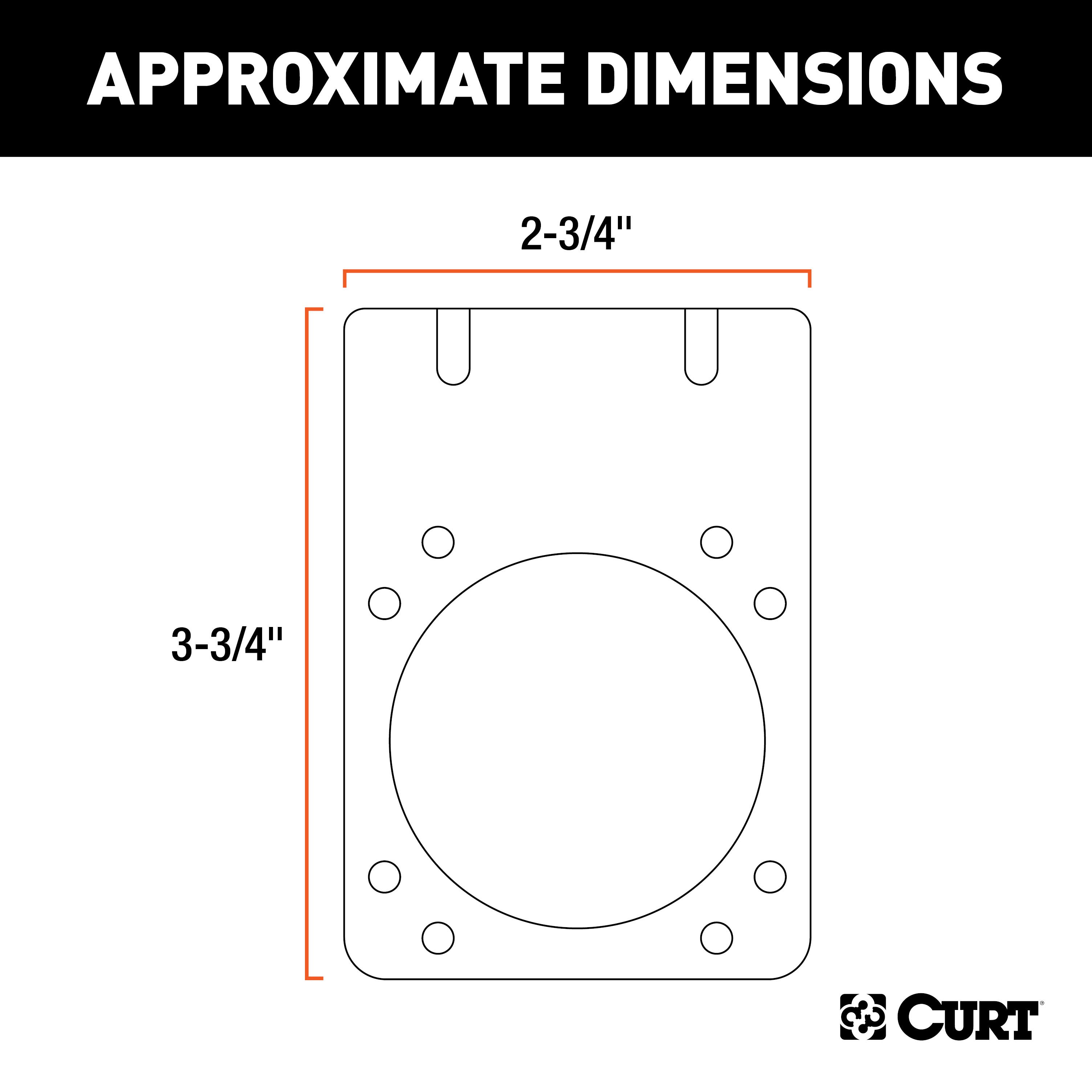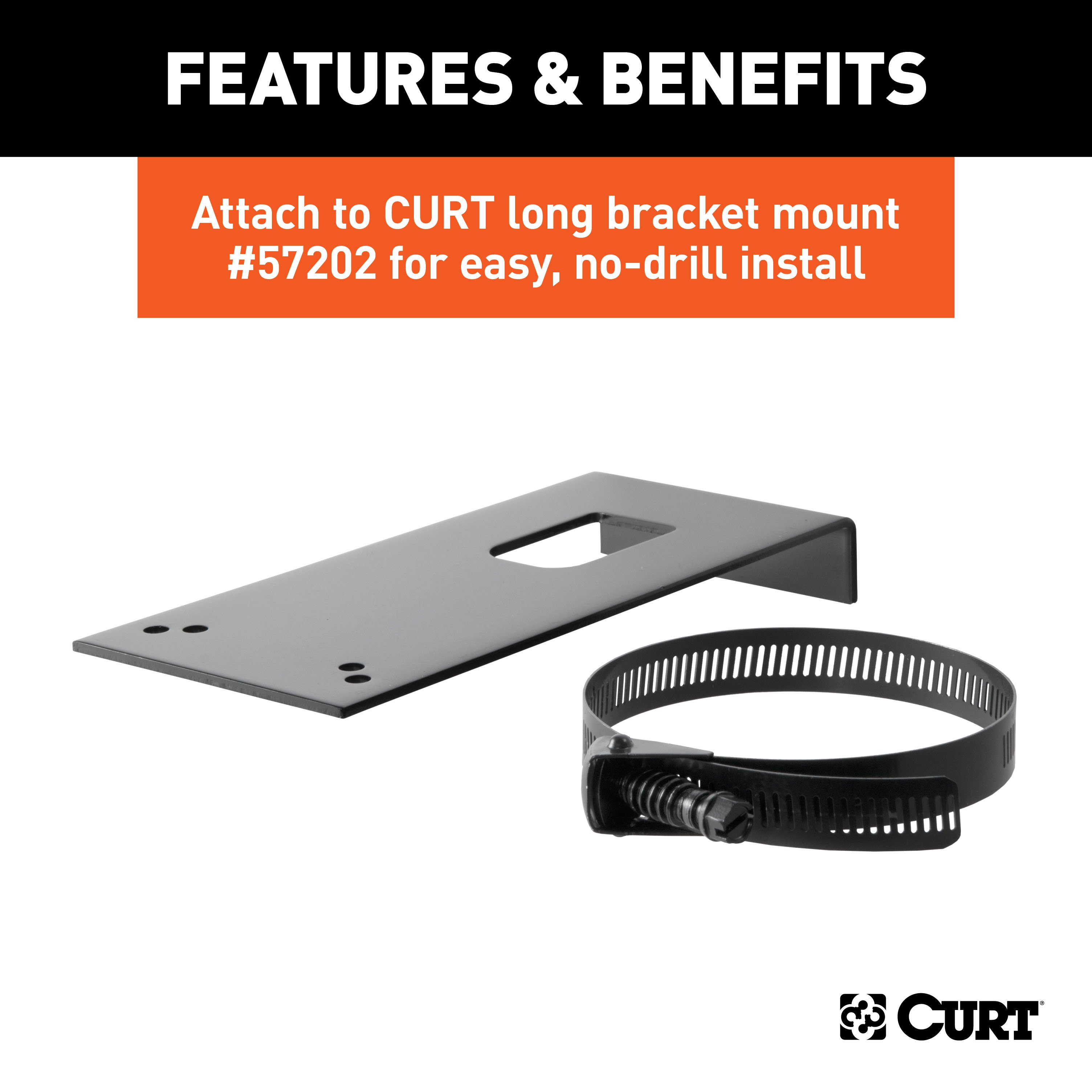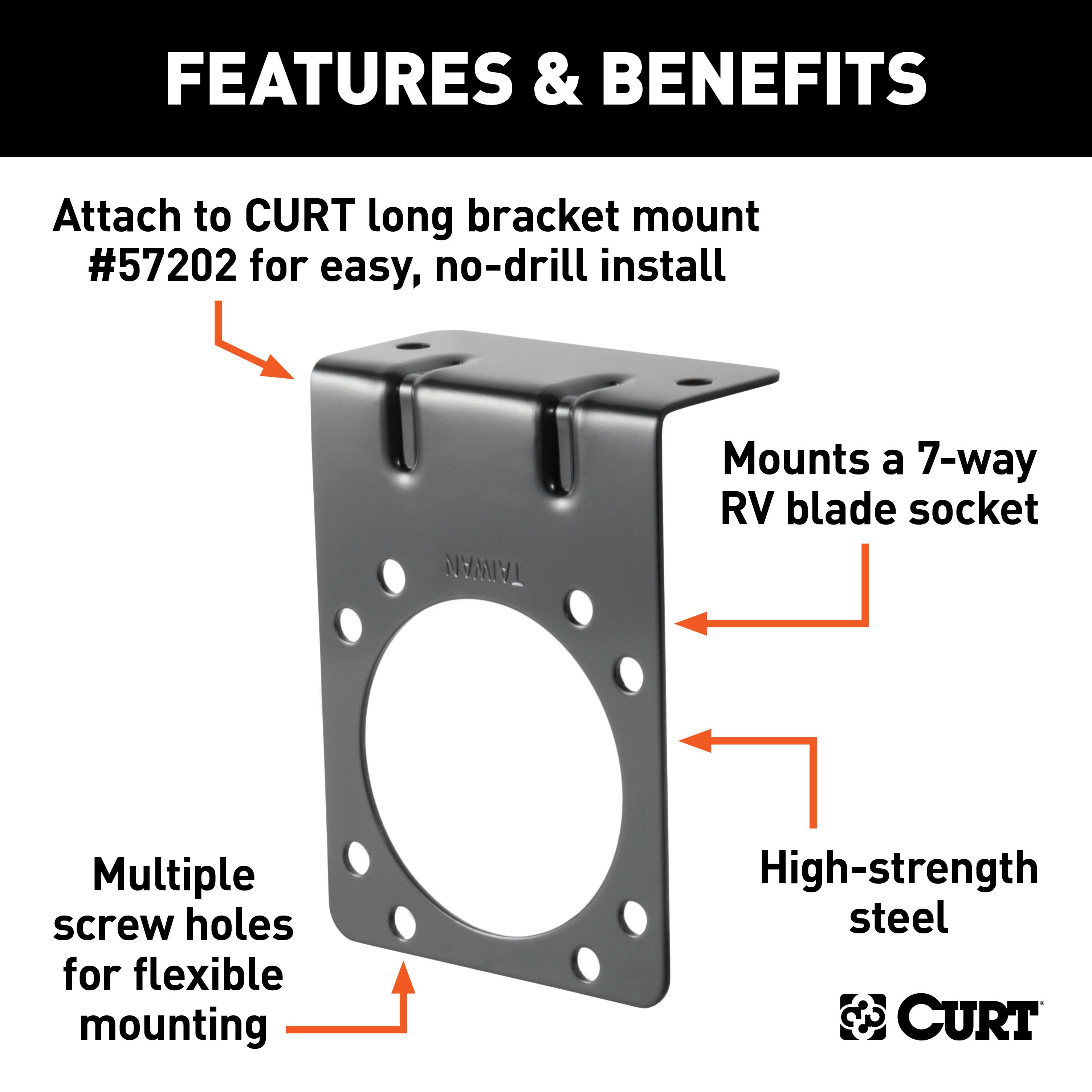Product Details
- Brand: Curt
- Model: 13355 51322 55243 58290 45042 51160-CH1550
- Includes: Class 3 Trailer Tow Hitch, Custom 7-Way RV Blade, Brake Controller Harness, Connector Mounting Bracket for 7-Way RV Blade Black), Loaded Ball Mount with 2-5/16" Ball 2" Shank, Assure Proportional Trailer Brake Controller with Dynamic Screen
Compatibility Chart
Description
Get Expert Help
For 1999-2001 Ford F350 Super Duty Tow Package Camp n' Field Trailer Hitch + Brake Controller Curt Assure 51160 Proportional Up To 4 Axles + 7 Way Trailer Wiring Plug & 2-5/16" ball 4 inch drop Fits Models w/ Factory 4-Flat Except Cab & Chass Install Notes
Installation Instructions for 1997-2003 Ford F-150 / F-250LD (New Body Style),
1999-Current Ford F-250 / F-350 Super Duty, and 2008-Current Ford F-450 Super Duty
Part Numbers:
- 13355
Tools Required:
- Torque wrench
- Ratchet
- 3/4" socket
Step-by-Step Instructions:
-
Lower the Spare Tire:
- Lower the spare tire to create working space.
- Note: The spare tire will be repositioned after the hitch installation.
-
Install Carriage Bolts and Spacers:
- Insert the 1/2" carriage bolts and square hole spacers through the existing holes in the vehicle frame rails as shown in the diagram.
-
Raise the Hitch into Position:
-
Raise the hitch into position over the installed carriage bolts.
-
Secure the hitch using flat washers, lock washers, and hex nuts.
-
Important: Ensure the wire harness near the end of the truck frame is not pinched between the hitch and frame.
-
Note: Only one of the two forward-most holes in the hitch side plates will be used, depending on the truck type:
- Light Duty Trucks: Use the rearward hole.
- Super Duty Trucks: Use the forward hole.
-
-
Torque Fasteners:
- Torque all 1/2" fasteners to 110 lb-ft.
-
Reinstall the Spare Tire:
- Raise the spare tire back into its storage location under the truck.
- Note: You may need to push the spare tire toward the front of the truck for proper clearance.
Hardware List:
- Carriage Bolt, 1/2-13 x 1-3/4, Grade 8, YZ: Qty 6 (Part No. 10-10272)
- Nut, Hex, 1/2-13, Grade 8, YZ: Qty 6 (Part No. 20-00171)
- Washer, Flat, 1/2, YZ: Qty 6 (Part No. 30-00133)
- Washer, Lock, 1/2, YZ: Qty 6 (Part No. 30-00153)
- .250 x 1.50 x 2.00" Square Hole Spacer: Qty 6 (Part No. CM-SP16)
Safety Notes:
- Gross Load Capacity (Weight Carrying Hitch): 6,000 lbs (trailer weight), 600 lbs (tongue weight).
- Gross Load Capacity (Weight Distribution Hitch): 10,000 lbs (trailer weight), 1,000 lbs (tongue weight).
- Do not exceed the vehicle manufacturer's recommended towing capacity.
- Periodically check the receiver hitch to ensure all fasteners are tight and structural components are sound.
Specifications:
- Hitch Weight: Not specified.
- Installation Time:
- Professional: 43 minutes
- Novice (DIY): 60 minutes
- Drilling Required: No
Manufacturer Notes:
- Warranty covers defects in material and workmanship at the time of purchase.
- Alterations, misuse, or improper installation voids the warranty.
- For technical support, call Curt Manufacturing at 1-877-287-8634.
Installation Instructions for 1997-2003 Ford F-150 / F-250LD (New Body Style),
1999-Current Ford F-250 / F-350 Super Duty, and 2008-Current Ford F-450 Super Duty
Part Numbers:
- 13355
Tools Required:
- Torque wrench
- Ratchet
- 3/4" socket
Step-by-Step Instructions:
-
Lower the Spare Tire:
- Lower the spare tire to create working space.
- Note: The spare tire will be repositioned after the hitch installation.
-
Install Carriage Bolts and Spacers:
- Insert the 1/2" carriage bolts and square hole spacers through the existing holes in the vehicle frame rails as shown in the diagram.
-
Raise the Hitch into Position:
-
Raise the hitch into position over the installed carriage bolts.
-
Secure the hitch using flat washers, lock washers, and hex nuts.
-
Important: Ensure the wire harness near the end of the truck frame is not pinched between the hitch and frame.
-
Note: Only one of the two forward-most holes in the hitch side plates will be used, depending on the truck type:
- Light Duty Trucks: Use the rearward hole.
- Super Duty Trucks: Use the forward hole.
-
-
Torque Fasteners:
- Torque all 1/2" fasteners to 110 lb-ft.
-
Reinstall the Spare Tire:
- Raise the spare tire back into its storage location under the truck.
- Note: You may need to push the spare tire toward the front of the truck for proper clearance.
Hardware List:
- Carriage Bolt, 1/2-13 x 1-3/4, Grade 8, YZ: Qty 6
- Nut, Hex, 1/2-13, Grade 8, YZ: Qty 6
- Washer, Flat, 1/2, YZ: Qty 6
- Washer, Lock, 1/2, YZ: Qty 6
- .250 x 1.50 x 2.00" Square Hole Spacer: Qty 6
Safety Notes:
- Gross Load Capacity (Weight Carrying Hitch): 6,000 lbs (trailer weight), 600 lbs (tongue weight).
- Gross Load Capacity (Weight Distribution Hitch): 10,000 lbs (trailer weight), 1,000 lbs (tongue weight).
- Do not exceed the vehicle manufacturer's recommended towing capacity.
- Periodically check the receiver hitch to ensure all fasteners are tight and structural components are sound.
Specifications:
- Hitch Weight: Not specified.
- Installation Time:
- Professional: 43 minutes
- Novice (DIY): 60 minutes
- Drilling Required: No
Warranty:
- Limited Warranty: Covers defects in material and workmanship at the time of purchase.
- Alterations, misuse, or improper installation voids the warranty.
- For complete warranty instructions, please download the full installation PDF.
Additional Notes:
- Attention: This is a summary of the installation procedure. For complete installation instructions, including diagrams and detailed information from the manufacturer, please download the full installation PDF.
- For technical support and assistance, our team of experts is available to help. You can reach our tech support by visiting www.trailerjacks.com or calling 877-869-6690.
Installation Instructions for Ford F-250 & F-350 Super Duty, and F-450 & F-550 Heritage
Part Numbers:
- 55243
Tools Required:
- Test light
- Electrical bracket or box (for socket mounting, not included)
Step-by-Step Instructions:
-
Locate the Vehicle’s Wiring Harness:
- Find the wiring harness plugs under the vehicle inside the driver-side frame rail.
- The plug should match the trailer wiring harness end.
- Disconnect the vehicle’s 4-flat plug or remove the protective cap.
- Connect the trailer tow harness into the mating plug.
-
Install the 7-Way Socket:
- Plug the 7-way socket into the harness.
- Mount the socket in an accessible location using a bracket or electrical box.
- Secure any loose wires.
-
Access the Power Distribution Box:
- In the engine compartment, disconnect the vehicle’s negative battery cable.
- Locate the vehicle’s power distribution box and the trailer tow relay block on the driver side.
- Open the covers to access the relays and fuses.
-
Insert the Fuses:
- Consult the owner’s manual to locate the following fuse slots:
- TRAILER TOW ELECTRIC BRAKE and TRAILER TOW BATTERY CHARGE.
- Insert the provided 30-amp maxi-fuses into these slots.
- Consult the owner’s manual to locate the following fuse slots:
-
Install the Relays:
- Consult the owner’s manual to locate the following relay slots:
- TRAILER TOW BACKUP LAMP RELAY and TRAILER TOW BATTERY CHARGE RELAY.
- Insert the provided relays into these slots.
- Consult the owner’s manual to locate the following relay slots:
-
Reconnect the Battery:
- Reconnect the vehicle’s negative battery cable.
-
Test the Installation:
- Use a test light or trailer to verify the functionality of the installed wiring harness and socket.
Hardware List:
- Trailer tow harness
- 7-way socket
- Two 30-amp maxi-fuses
- Two relays
Safety Notes:
- Verify there are no hidden items behind or under any surfaces before drilling to avoid damage or injury.
- Ensure all connections are secure to prevent electrical issues during operation.
Manufacturer Notes:
- Follow all steps carefully to ensure proper installation.
- Refer to the vehicle owner’s manual for specific fuse and relay locations.
- Test the installation thoroughly to confirm full functionality.
Installation Instructions for Ford F-250 & F-350 Super Duty, and F-450 & F-550 Heritage
Part Numbers:
- 55243
Tools Required:
- Test light
- Electrical bracket or box (for socket mounting, not included)
Step-by-Step Instructions:
-
Locate the Vehicle’s Wiring Harness:
- Find the wiring harness plugs under the vehicle inside the driver-side frame rail.
- The plug should match the trailer wiring harness end.
- Disconnect the vehicle’s 4-flat plug or remove the protective cap.
- Connect the trailer tow harness into the mating plug.
-
Install the 7-Way Socket:
- Plug the 7-way socket into the harness.
- Mount the socket in an accessible location using a bracket or electrical box.
- Secure any loose wires.
-
Access the Power Distribution Box:
- In the engine compartment, disconnect the vehicle’s negative battery cable.
- Locate the vehicle’s power distribution box and the trailer tow relay block on the driver side.
- Open the covers to access the relays and fuses.
-
Insert the Fuses:
- Consult the owner’s manual to locate the following fuse slots:
- TRAILER TOW ELECTRIC BRAKE and TRAILER TOW BATTERY CHARGE.
- Insert the provided 30-amp maxi-fuses into these slots.
- Consult the owner’s manual to locate the following fuse slots:
-
Install the Relays:
- Consult the owner’s manual to locate the following relay slots:
- TRAILER TOW BACKUP LAMP RELAY and TRAILER TOW BATTERY CHARGE RELAY.
- Insert the provided relays into these slots.
- Consult the owner’s manual to locate the following relay slots:
-
Reconnect the Battery:
- Reconnect the vehicle’s negative battery cable.
-
Test the Installation:
- Use a test light or trailer to verify the functionality of the installed wiring harness and socket.
Hardware List:
- Trailer tow harness
- 7-way socket
- Two 30-amp maxi-fuses
- Two relays
Safety Notes:
- Verify there are no hidden items behind or under any surfaces before drilling to avoid damage or injury.
- Ensure all connections are secure to prevent electrical issues during operation.
Manufacturer Notes:
- Follow all steps carefully to ensure proper installation.
- Refer to the vehicle owner’s manual for specific fuse and relay locations.
- Test the installation thoroughly to confirm full functionality.
Attention:
This is a summary of the installation procedure. For complete installation instructions, including diagrams and detailed information from the manufacturer, please download the full installation PDF.
For Technical Support and Assistance:
Our team of experts is available to help. You can reach our tech support by visiting www.trailerjacks.com or calling 877-869-6690.
Warranty:
For complete warranty instructions, please download the full installation PDF.
Installation Instructions for 4-Way to 7-Way Adapter and Brake Control Wiring
Tools Required:
- Phillips Head Screwdriver
- Drill with 3/32" Drill Bit
- 10mm Socket & Ratchet or Wrench
- Wire Crimpers
- Wire Cutters
- Test Light or Multimeter
- Cable Ties
Part 1: Install the 4-Way to 7-Way Adapter
Step-by-Step Instructions:
-
Mount the Adapter:
- Choose a suitable mounting point on the vehicle, typically near the hitch.
- Use the provided bracket and screws to secure the adapter.
-
Connect the 4-Flat Plug:
- Plug the 4-flat connector on the adapter into the existing 4-flat plug on the vehicle.
- This connection enables tail lights, left turn, and right turn signals.
-
Ground the Adapter:
- Locate a clean, solid grounding point near the adapter.
- Drill a 3/32" hole if necessary and secure the white ground wire from the adapter using the provided screw and eyelet.
-
Leave Additional Wires Disconnected:
- The following wires will remain disconnected until Part 2:
- Black Wire: Power from the battery.
- Blue Wire: Brake control output.
- Yellow Wire: Reverse light (optional; leave disconnected unless needed).
- The following wires will remain disconnected until Part 2:
-
Test Initial Connection:
- Use a test light or trailer to verify functionality of the 4-way connections (tail lights, turn signals).
Part 2: Install Brake Control Wiring
Step-by-Step Instructions:
-
Mount Circuit Breakers:
- Install two 30A circuit breakers on the firewall or another suitable location near the battery.
- Use self-tapping screws to mount them securely.
-
Route Power Wires:
- Connect the black 12-gauge wire from the 7-way adapter to the auxiliary side of one circuit breaker (this powers the 7-way socket).
- Run a heavy-gauge wire from the battery's positive terminal to the battery side of this circuit breaker, using a ring terminal.
- Run another heavy-gauge wire from the battery's positive terminal to the auxiliary side of the second circuit breaker (for the brake controller).
-
Install the Brake Controller:
- Mount the brake controller under the dash on a firm surface.
- Use the following connections:
- Red Wire: Connect to the cold side of the brake switch (active only when the brake pedal is pressed).
- Blue Wire: Connect to the blue wire on the 7-way adapter for trailer brakes.
- White Wire: Connect to a solid ground point on the vehicle body.
- Black Wire: Connect to the auxiliary side of the second 30A circuit breaker (provides power to the brake controller).
-
Optional: Connect Reverse Light Circuit:
- If the trailer has a reverse light circuit, connect the yellow wire from the 7-way adapter to the vehicle’s reverse light circuit.
-
Reconnect the Battery:
- Reattach the negative battery cable and ensure all connections are secure.
- Insert the fuses into both circuit breakers.
-
Secure All Wires:
- Use cable ties to secure all loose wires and prevent damage or rattling.
-
Test the System:
- Verify functionality of all circuits (running lights, turn signals, brake lights, and brake controller output).
- If applicable, test the reverse light circuit.
Notes:
- Most installations will only require connecting the black and blue wires from the 7-way adapter.
- Leave the yellow wire disconnected unless the trailer has a reverse light or surge brake lockout circuit.
- Always adhere to safety guidelines and verify all connections before use.
Warning: Incorrect wiring can cause damage to the vehicle or trailer. Test all connections carefully before use.
Installation Instructions for 4-Way to 7-Way Adapter and Brake Control Wiring
Tools Required:
- Phillips Head Screwdriver
- Drill with 3/32" Drill Bit
- 10mm Socket & Ratchet or Wrench
- Wire Crimpers
- Wire Cutters
- Test Light or Multimeter
- Cable Ties
Part 1: Install the 4-Way to 7-Way Adapter
Step-by-Step Instructions:
-
Mount the Adapter:
- Choose a suitable mounting point on the vehicle, typically near the hitch.
- Use the provided bracket and screws to secure the adapter.
-
Connect the 4-Flat Plug:
- Plug the 4-flat connector on the adapter into the existing 4-flat plug on the vehicle.
- This connection enables tail lights, left turn, and right turn signals.
-
Ground the Adapter:
- Locate a clean, solid grounding point near the adapter.
- Drill a 3/32" hole if necessary and secure the white ground wire from the adapter using the provided screw and eyelet.
-
Leave Additional Wires Disconnected:
- The following wires will remain disconnected until Part 2:
- Black Wire: Power from the battery.
- Blue Wire: Brake control output.
- Yellow Wire: Reverse light (optional; leave disconnected unless needed).
- The following wires will remain disconnected until Part 2:
-
Test Initial Connection:
- Use a test light or trailer to verify functionality of the 4-way connections (tail lights, turn signals).
Part 2: Install Brake Control Wiring
Step-by-Step Instructions:
-
Mount Circuit Breakers:
- Install two 30A circuit breakers on the firewall or another suitable location near the battery.
- Use self-tapping screws to mount them securely.
-
Route Power Wires:
- Connect the black 12-gauge wire from the 7-way adapter to the auxiliary side of one circuit breaker (this powers the 7-way socket).
- Run a heavy-gauge wire from the battery's positive terminal to the battery side of this circuit breaker, using a ring terminal.
- Run another heavy-gauge wire from the battery's positive terminal to the auxiliary side of the second circuit breaker (for the brake controller).
-
Install the Brake Controller:
- Mount the brake controller under the dash on a firm surface.
- Use the following connections:
- Red Wire: Connect to the cold side of the brake switch (active only when the brake pedal is pressed).
- Blue Wire: Connect to the blue wire on the 7-way adapter for trailer brakes.
- White Wire: Connect to a solid ground point on the vehicle body.
- Black Wire: Connect to the auxiliary side of the second 30A circuit breaker (provides power to the brake controller).
-
Optional: Connect Reverse Light Circuit:
- If the trailer has a reverse light circuit, connect the yellow wire from the 7-way adapter to the vehicle’s reverse light circuit.
-
Reconnect the Battery:
- Reattach the negative battery cable and ensure all connections are secure.
- Insert the fuses into both circuit breakers.
-
Secure All Wires:
- Use cable ties to secure all loose wires and prevent damage or rattling.
-
Test the System:
- Verify functionality of all circuits (running lights, turn signals, brake lights, and brake controller output).
- If applicable, test the reverse light circuit.
Notes:
- Most installations will only require connecting the black and blue wires from the 7-way adapter.
- Leave the yellow wire disconnected unless the trailer has a reverse light or surge brake lockout circuit.
- Always adhere to safety guidelines and verify all connections before use.
Warning: Incorrect wiring can cause damage to the vehicle or trailer. Test all connections carefully before use.
Attention:
This is a summary of the installation procedure. For complete installation instructions, including diagrams and detailed information from the manufacturer, please download the full installation PDF.
Warranty Information:
For complete warranty instructions, please download the full installation PDF.
Technical Support:
For technical support and assistance, our team of experts is available to help. You can reach our tech support by visiting www.trailerjacks.com or calling 877-869-6690.
Installation Instructions for Ford Vehicles
Part Numbers:
- 51322
Wiring Access Location:
- BH1 - Under dash, left of steering column, near emergency brake pedal (Ford Econoline Van, Ford Explorer)
- BH2 - Under dash, near center console (All Other Vehicles)
Tools Required:
- Socket (7mm, 10mm)
- Ratchet
- Socket extension
- Panel trim removal tool
Step-by-Step Instructions:
Step 1A: Locate the harness connector (Ford Econoline Van)
- Find the 6-pin vehicle brake control harness connector under the dash, to the left of the steering column.
Step 1B: Locate the harness connector (Ford Explorer)
- If equipped, remove the plastic panel under the dash by loosening the 7mm and 10mm bolts securing it.
- Locate the metal bracket above the brake pedal at the center of the driver-side foot compartment.
- The brake control harness will be mounted with a push fastener on top of the bracket.
- The fastener can be removed to assist installation but is not required.
Step 1C: Locate the harness connector (All Other Vehicles)
- Find the 6-pin vehicle brake control harness connector under the dash, near the center console.
- The connector will resemble the brake control harness.
Step 2: Verify power to the connector
- Check for battery power at the connector using a test light or by tracing the wires to their source.
- If power is supplied, skip to Step 4.
Step 3: Install a universal brake control wiring kit (if necessary)
- If no power is supplied, install a universal brake control wiring kit (#51500):
- Cut the battery wire leading to the factory connector, leaving enough room to use a butt connector.
- Attach this wire to the battery wire from the universal wiring kit.
- Cut the trailer brake wire leading to the factory connector, leaving enough room to use a butt connector.
- Attach this wire to the trailer brake wire from the universal wiring kit.
- Warning: Cap or tape the exposed ends of cut wires to prevent shorting.
Step 4: Connect the CURT brake control harness
- Insert the custom brake control harness connector into the vehicle connector.
- Ensure the connector is fully inserted and the locking tabs are secure.
Step 5: Connect to the brake control unit
- Insert the black connector of the brake control harness into the brake control's quick plug connector.
- Secure the harness using the provided cable ties, avoiding pinch points.
- Complete the installation using the brake control instructions.
- Mount the unit and perform the recommended test procedures.
Hardware List:
- (1) CURT brake control harness
- (2) Cable ties
Safety Notes:
- Periodically inspect all wires and connections to ensure there is no visible damage or loose connections.
- Do not exceed the product rating or the tow vehicle lamp load rating, whichever is lower.
Specifications:
- Compatible Vehicles:
- Ford Econoline Van
- Ford Explorer
- Ford Vehicles with BH1 or BH2 wiring locations
Installation Instructions for Ford Vehicles
Part Numbers:
- 51322
Wiring Access Location:
- BH1 - Under dash, left of steering column, near emergency brake pedal (For select vehicles)
- BH2 - Under dash, near center console (For all other vehicles)
Tools Required:
- Socket (7mm, 10mm)
- Ratchet
- Socket extension
- Panel trim removal tool
Step-by-Step Instructions:
Step 1A: Locate the harness connector (For select vehicles)
- Find the 6-pin vehicle brake control harness connector under the dash, to the left of the steering column.
Step 1B: Locate the harness connector (For select vehicles)
- If equipped, remove the plastic panel under the dash by loosening the 7mm and 10mm bolts securing it.
- Locate the metal bracket above the brake pedal at the center of the driver-side foot compartment.
- The brake control harness will be mounted with a push fastener on top of the bracket.
- The fastener can be removed to assist installation but is not required.
Step 1C: Locate the harness connector (For all other vehicles)
- Find the 6-pin vehicle brake control harness connector under the dash, near the center console.
- The connector will resemble the brake control harness.
Step 2: Verify power to the connector
- Check for battery power at the connector using a test light or by tracing the wires to their source.
- If power is supplied, skip to Step 4.
Step 3: Install a universal brake control wiring kit (if necessary)
- If no power is supplied, install a universal brake control wiring kit (#51500):
- Cut the battery wire leading to the factory connector, leaving enough room to use a butt connector.
- Attach this wire to the battery wire from the universal wiring kit.
- Cut the trailer brake wire leading to the factory connector, leaving enough room to use a butt connector.
- Attach this wire to the trailer brake wire from the universal wiring kit.
- Warning: Cap or tape the exposed ends of cut wires to prevent shorting.
Step 4: Connect the brake control harness
- Insert the custom brake control harness connector into the vehicle connector.
- Ensure the connector is fully inserted and the locking tabs are secure.
Step 5: Connect to the brake control unit
- Insert the black connector of the brake control harness into the brake control's quick plug connector.
- Secure the harness using the provided cable ties, avoiding pinch points.
- Complete the installation using the brake control instructions.
- Mount the unit and perform the recommended test procedures.
Hardware List:
- (1) Brake control harness
- (2) Cable ties
Safety Notes:
- Periodically inspect all wires and connections to ensure there is no visible damage or loose connections.
- Do not exceed the product rating or the tow vehicle lamp load rating, whichever is lower.
Specifications:
- Compatible Vehicles:
- Vehicles with BH1 or BH2 wiring locations
For complete installation instructions, including diagrams and detailed information from the manufacturer, please download the full installation PDF.
For technical support and assistance, our team of experts is available to help. You can reach our tech support by visiting www.trailerjacks.com or calling 877-869-6690.
Installation Instructions for Brake Controller
Product Information:
- Application: For trailers with 2 to 8 brakes
- System: 12-volt negative ground systems
Package Contents:
- (1) Brake Controller Module with Quick Plug
- (1) Mounting Bracket
- (2) Keyed Spacers
- (4) Mounting Bracket Screws
- (1) Quick Reference Card
- (2) Keyed Washers
Tools Required:
- Drill with 1/8" drill bit
- Wire Crimpers
- Wire Cutters
- Phillips Head Screwdriver
Key Features:
- Display for output and sensitivity settings
- Manual trailer braking control
- Switchable manual control options (100% or output setting)
- Brake light activation switch
- Reverse voltage and overload protection
- Compatible with electric and hydraulic trailer brake systems
Warnings and Important Notes:
- The brake controller’s positive and ground wires must connect directly to the vehicle’s battery with 10-gauge stranded wire.
- Avoid mounting near a CB radio or other RF transmitters.
- Disconnect the trailer plug when testing a breakaway switch.
Step-by-Step Installation Instructions:
1. Select the Mounting Location:
- The mounting location should be:
- Within the driver’s reach
- On a solid surface
- Free of obstructions behind the mounting surface
2. Install the Mounting Bracket:
- Position the bracket and mark the mounting holes.
- Drill holes using a 1/8” drill bit.
- Secure the bracket with the provided self-tapping screws (do not overtighten).
3. Attach the Brake Controller:
- Place the keyed spacer and washer on each side of the mounting bracket.
- Slide the brake controller into the bracket and secure it with screws.
4. Wiring the Brake Controller:
- Black Wire (Power Input): Connect to the positive (+) battery terminal through a 30-amp auto-reset circuit breaker.
- White Wire (Ground): Connect directly to the negative (-) battery terminal.
- Red Wire (Stoplight Input): Connect to the stoplight wire that is “hot” only when the brake pedal is pressed.
- Use a test probe to verify the correct wire.
- Blue Wire (Brake Output): Connect to the trailer’s brake control wire through the 7-way connector.
Switch Settings (Manual Control Configuration):
-
Brake Light Activation Switch:
- ON: Activates brake lights when the manual control is used (default).
- OFF: Brake lights remain inactive during manual braking.
-
Manual Brake Output Switch:
- ON: Limits manual braking to the gain (output) setting.
- OFF: Allows 100% braking power regardless of the output setting.
Setup and Calibration:
-
Connect the Trailer:
- Plug the trailer connector into the vehicle’s 7-way outlet.
- The controller will calibrate automatically, displaying "Calibration" followed by "Connected."
-
Set Initial Output and Sensitivity:
- Set the output to 2.0 and sensitivity (load) to 1.0 using the (+) and (-) buttons.
-
Test Drive and Adjust:
- Drive on a level surface at 25 mph.
- Press the brake pedal:
- Increase Output: If trailer braking feels insufficient.
- Decrease Output: If trailer brakes lock up.
- Adjust sensitivity for smoother stops using the (+) and (-) buttons.
Display Indicators:
| Indicator | Description |
|---|---|
| Connected | Trailer connected, standby mode |
| Not Connected | No trailer detected |
| Low Volt | Tow vehicle system voltage is low |
| Overload | Trailer brake system fault detected |
| Short | Stoplight wire shorted to ground |
| Error | Accelerometer error |
| Disconnect | Trailer disconnected |
Troubleshooting Guide:
- Display is Blank: Check power and ground connections.
- Display Shows "Low Volt": Verify vehicle’s battery and charging system.
- "Overload" Error: Inspect the blue wire and trailer brake circuit for shorts.
- No Trailer Brakes: Confirm proper wiring of the trailer connector.
Final Notes:
- Secure all loose wires with cable ties.
- Periodically test the system for proper operation.
- Avoid exceeding the towing vehicle's maximum electrical capacity.
Attention: This is a summary of the installation procedure. For complete installation instructions, including diagrams and detailed information, download the full installation PDF.
For Technical Support: Our team of experts is available to help. You can reach tech support by visiting www.trailerjacks.com or calling 877-869-6690.


























































































